 By Pepper Parr By Pepper Parr
April 17th, 2017
BURLINGTON, ON
What are the issues facing the eleven members of the Halton District School Board as they review the information that is going to be fed to them by Board staff and the delegations that are made by parents who do not want to see the school their children attend closed?
There are currently about 550 high school students taking a bus to get to school.
Using the different high school closing options the following is the projections that was given to the PAR committee.
Busing increases:
Nelson closes – add 364 students to the busing number
Bateman only add 262 students to the busing number
No schools close add 131 students to the busing number
Central and Pearson close add 602 students to the busing number
Bateman and Pearson close add 286 students to the busing number
Central and Pearson close add 615 students to the busing number
The projection is that more than 1000 students will be riding a school bus if Central high school is closed where a reported 92% of the students walk to school.
The cost of transporting those students is said to amount to $400,000 per year.
The amount of money aside – the real issue for the Board is going to be finding the people to drive those school buses. The Board doesn’t actually have to find the drivers – the company they contract with has to find the drivers – but it all boils down to the same thing – school bus drivers don’t get paid very much
 Early in this academic year there were desperate pleas from the HSTS – Halton Student Transportation Service for people to apply for a part time job driving a school bus. Early in this academic year there were desperate pleas from the HSTS – Halton Student Transportation Service for people to apply for a part time job driving a school bus.
School bus drivers get between $55 and $75 a day; there are no benefits and they get paid for just the days they drive a bus. A source told the Gazette that school bus drivers are amongst the highest users of Food Bank services in Halton. This is an operation that is ripe for unionization.
The HSTS is a corporation owned by the Halton District School Board and the Halton Catholic District School Board and is operated on a cost recovery basis.
The French Catholic School Board was at one time part of the consortium but they dropped out.
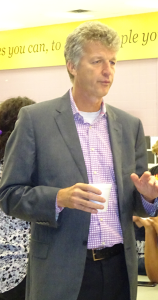 Director of Education Stuart Miller Stuart Miller, the Director of Education, has said that his Board has no idea how the manpower problem will get resolved in the event that the trustees decide Central high school should be closed. He has not said if there are any contingency plans being developed.
No one, apparently, taken a look at what student life will look like if 1000+ students are riding school buses to get to their classes.
What happens to sports teams?
What about student clubs?
What about their social life – how do they hang around and chill out and learn from each other?
The environmentalists will talk about the tonnes of CO2 the buses will pump into the air and they won’t do much for traffic congestion either.
Will there be two classes of high school students: one social class that uses a school bus and is limited in what they can do extra-curricularly because of the school bus schedule and another class of student that can walk or ride their bikes or have their parents act as chauffeurs?
These are all serious and significant issues – someone should be thinking about what the impact is going to be or will be looking at unintended consequences once we are six or seven months into a new school bus program?
The answers to the questions – or at last some kind of a projection should have been prepared by Board staff so that both the trustees and the parents have some idea of what the consequences are if a lot of high school students have to catch that bus every morning – and every afternoon.
What would a day in the life of a high school student look like if they were attached with close to an umbilical cord to a bright yellow school bus?

 By Pepper Parr By Pepper Parr
April 18th, 2017
BURLINGTON, ON
The Halton District School Board Program Accommodation Review Committee (PARC) has been wound down and thanked for the superb job they did. The community now waits to see what impact their deliberations will have on the report Director of Education Stuart Miller delivers to the public and the trustees this Friday.
The report is to be published on line by Board Staff at 6:00 pm on Friday. (Hopefully the web site will manage to handle the demand for the report.)
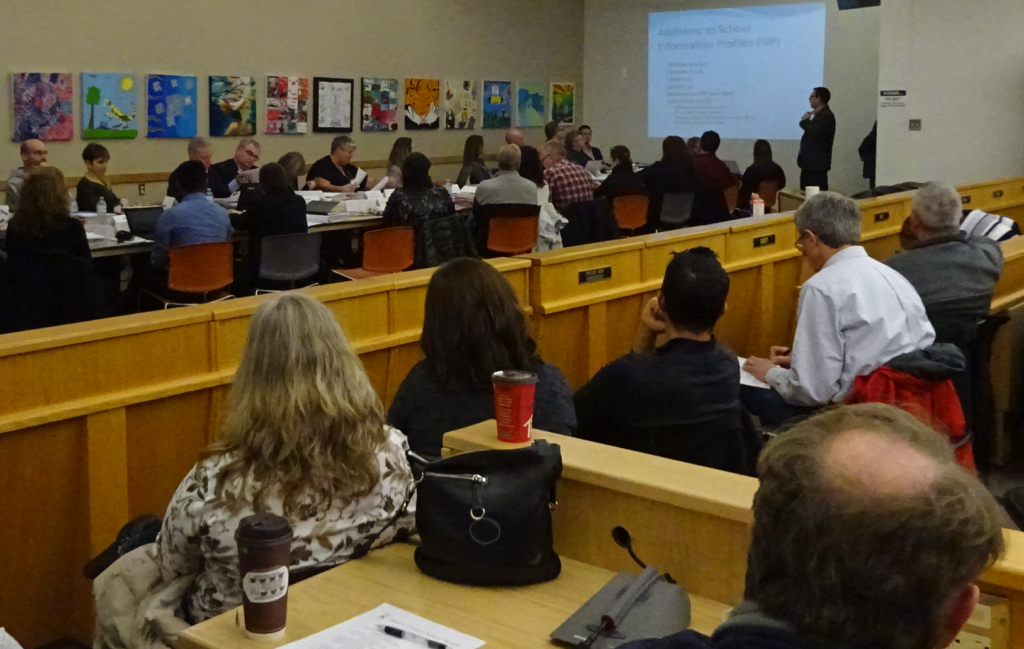 Halton District School Board PARC committee meeting while public observes the deliberations. It was a committee that required a couple of meetings to find itself – many of the people did not know each other very well or at all.
Many of the people on the PARC had serious concerns with the process that was being used. Central high school parents challenged the Board on the approach it was taking to what was a new process put in place by the provincial government. The high school parents lost that argument.
Add to this the significant concern with the Central high school choice of Marianne Meed Ward as their nominee to the PARC. Being the member of council for ward 2 and agreeing to serve on the PARC did not sit well with many.
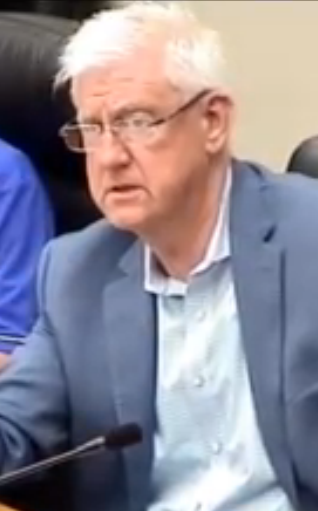 Ward 5 City Councillor |Paul Sharman. Bateman high school is in his ward. He had to be seen going to bat for them. Burlington city council was firm on not getting involved – that was until Bateman high school was listed as a possible school closure – that brought Ward 5 council member Paul Sharman into play. He strode into one of the PARC meetings to observe for he now had political skin in the game.
He then brought a motion to have the city write a letter to the Minister of Education to bring a halt to the PARC that was meeting in Burlington. That vote at city council lost 5-2.
But Sharman had shown that he would go to bat for his people – which was his purpose from the get go.
Meed Ward has always been a feisty member of Council – she was one of the more active delegators to city council before she was elected and she was the member of council who asked more questions than any other member of council once she got herself elected in ward 2.
She would call for recorded votes frequently and on one memorable occasion she had her colleagues on their feet five times for recorded votes. It was at that point that we saw just how much the members of Council could roll their eyeballs.
 Councillor Marianne Meed Ward with the Mayor in Spencer Smith Park. Many hoped the same “in your face” Meed Ward would be seen at the PARC meetings. For the most part that Meed Ward didn’t show up.
She was active, she asked solid questions and was supported by a parents group that did some fine research and supported her with demonstration after demonstration.
But the voice we heard at the PARC meetings wasn’t what many had expected.
Was Meed Ward curtailed at all by the objections to her being one of the Central high school PARC members? Curtail isn’t a word one would normally apply to Meed Ward.
Her colleagues on city council weren’t the least bit pleased – they have never been pleased with the way Meed Ward does politics in this city.
Some felt that if Meed Ward could lead the charge to save Central high school she would be seen as a shoo in for Mayor when the 2018 municipal election takes place.
The woman who has led many charges at city council wasn’t seen that often – if at all – at the PARC meetings. Admittedly she wasn’t in an environment she was familiar with – but then none of the PARC members knew much about the workings of the school board.
During a meeting of Central high school parents Meed Ward reported to them and said that while she was basically an optimistic person – she was concerned about the direction the discussions were going in.
Shortly after that meeting at the Lions Club – an at first subtle shift began to take place within the PARC and the option the Board Staff put forward to close both Central high school and Pearson began to lose to the idea of not closing any of the high schools.
That option was the clear choice of the PARC committee when it was disbanded.
The Director’s report will be released Friday – if the recommendation Director of Education Miller makes to the trustees is to not close any of the high schools the PARC will get much of the credit – Meed Ward will be seen as just another member of that committee.
If Miller, no matter how reluctantly, recommends closing Central, that community will erupt. What role will Meed Ward play in that eruption? It is not going to be pretty. She is no longer a member of the PARC – there is no PARC – it was disbanded.
She will certainly protest as a parent but the clout she had as a PARC member will have evaporated.
There were several members of the PARC that were exceptional in the way they moved the agenda; at times they came close to taking it out of the hands of the PARC Chair, School Board Superintendent Scott Podrebarac.
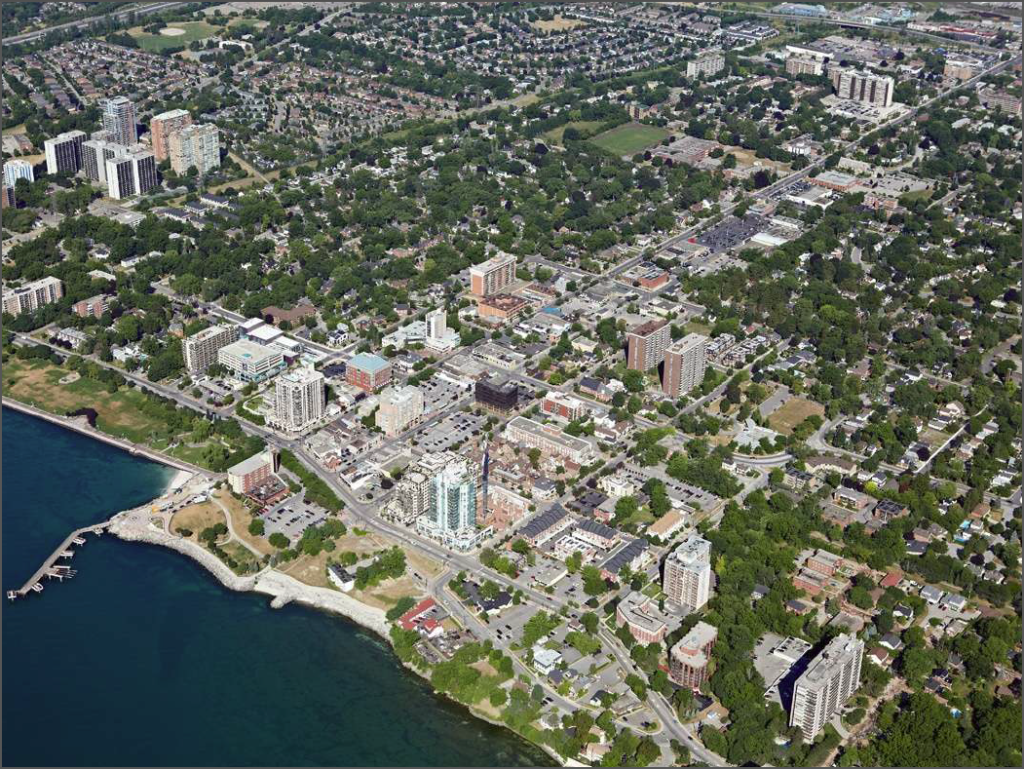 What impact would the closing of the downtown high school have on the city? Much bigger than most can even imagine. It will be interesting to see just how Meed Ward handles herself when the report is released on Friday.
Everyone will be reading the report carefully – we do know that it is going to be a lengthy document with every department at the School Board having a significant impact.
Burlington can expect to see two things during the weekend: what kind of a Director of Education is Stuart Miller going to choose to be and how will a candidate for the office of mayor position herself on the most significant decision about the health and long term welfare of the city we have had to face in the last 15 years.
It will be interesting.

 By Pepper Parr By Pepper Parr
April 17th, 2017
BURLINGTON, ON
It is now down to the eleven trustees – they will determine if any of the high schools in Burlington are to be closed.
The Program Accommodation Review Committee (PARC) that was created did some superb work – the Board Staff were taken aback a bit at how persistent and diligent they were.
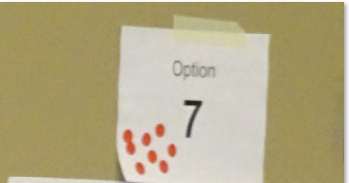 During the first occasion when PARC members were asked to rank their choices # 7 – Don’t close any high school was not all that high on the list. That changed and it now appears to be the option the PARC would prefer. 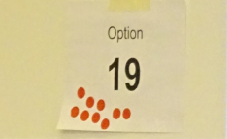 Option #19 – to Close both Central and Pearson was the Board Staff recommendation and the one that the the PARC members ranked higher than the option to not close any of the high schools. Option # 19 is no longer on the list of options that the PARC left on the table. The option of not closing any of the schools was barely on the table when the PARC process began and at the early look at where the PARC members stood what was known as Option # 7 didn’t rank all that well – but sentiment for that option grew and by the end of the PARC process it was the clear preference, with the trustee serving as an advisor to the PARC asking how not closing any of the schools could be made to happen.
That question could have and should have been put to the Board staff – they are the people well paid to run the educational system for the Region – which is something that can be looked at in the future.
For now – the voters are going to have to coax their trustees to act in the interests of the community and not be taken too far by the preferences of the Board staff.
A number of months ago the Gazette asked the eleven trustees to rank the following in terms of their importance to the individual trustee.
 Board chair Kelly Amos At that time Board Chair Kelly Amos said the trustees did not want to attempt to influence that PARC in any way. Fair enough – but the PARC has now been dissolved. Could the people who elected the trustees know where those trustees stand on the following:
Fiscal prudence
Academic offerings
Community
One isn’t better than another – the intention was to get some understanding as to what the values were of each trustee so that when people delegate they can put forward arguments that would resonate with the trustees.
At a recent parent council meeting at Lester B. Pearson high school a small audience held trustee Papin’s feet to the flames when they asked her to tell them she was going to support their school.
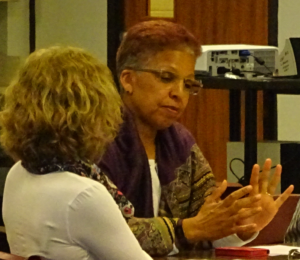 Burlington’s Ward 4 school board trustee Richelle Papin Papin was in a difficult spot – two of the schools in her ward are amongst the options for closing. Both Pearson and Nelson are in ward 4. That is what they call a “sticky wicket”.
Papin could have very easily said she was for Option # 7 – keep all the schools open and direct staff to find a way to pay for it. The Director of Education has already said this was not a money issue and that the Board did not have to close any of the schools.
Papin didn’t seem to be able to assure the Pearson parents – her response was that she didn’t yet have all the information yet.
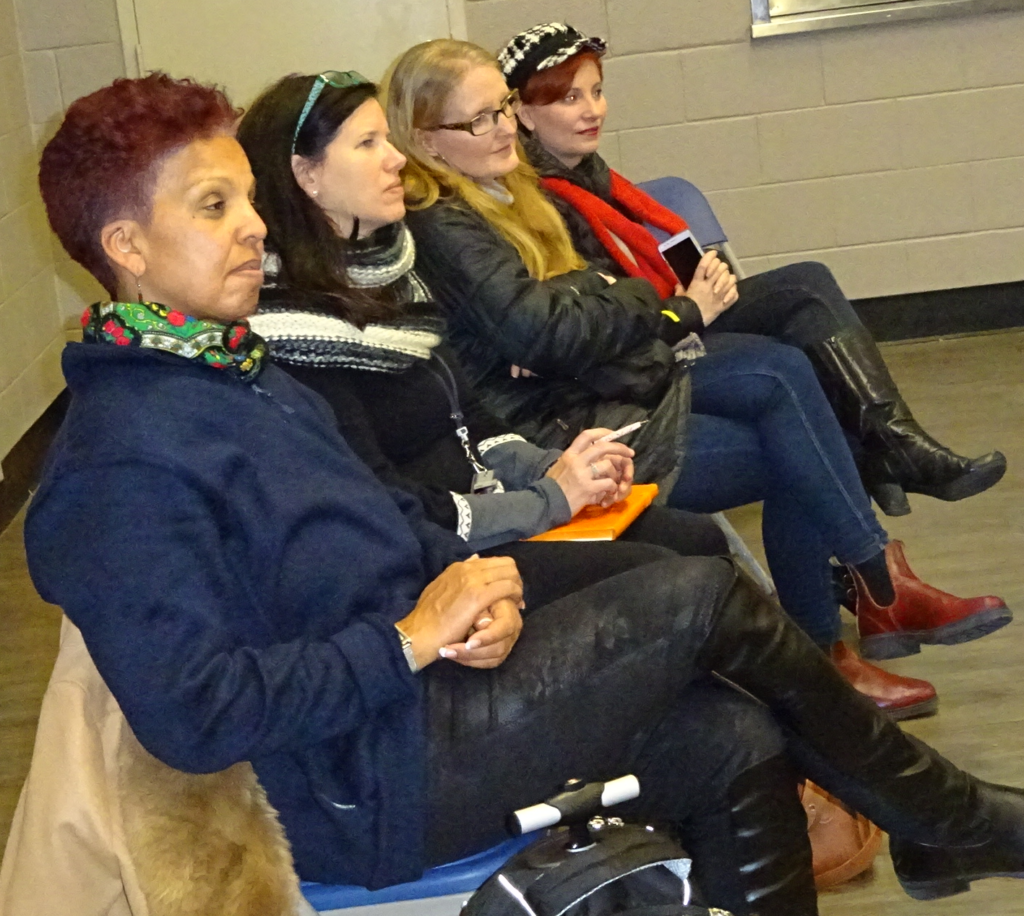 Four of the eleven Halton District School Board trustees sitting in on one of the public meetings. The trustees need to be decisive and represent the interests of their communities using the values they hold as a guide. Is fiscal prudence more important than community? Is the academic offering more important that fiscal prudence? Tough questions – there is no right or wrong answer – it is a question of individual values. The 11 trustees are going to make a critical decision for the city of Burlington – what are they going to base that decision on?

 By Pepper Parr By Pepper Parr
April 16th, 2017
BURLINGTON, ON
The weather could have been better but that didn’t matter all that much for Stuart Miller, Halton District School Board, Director of Education – the top position in a school board; he was busy thinking through the report that will be made public Friday April 21st on which, if any, high schools in Burlington should be closed.
Millers report to the Board of Trustees last October was that both Central High school and Lester B. Pearson high school need to be closed because the board has 1800 seats that do not have students in them.
When the report was released to the Trustees they had to make a decision, which they did – that was to create a Program Accommodation Review which called for the creation of a committee.
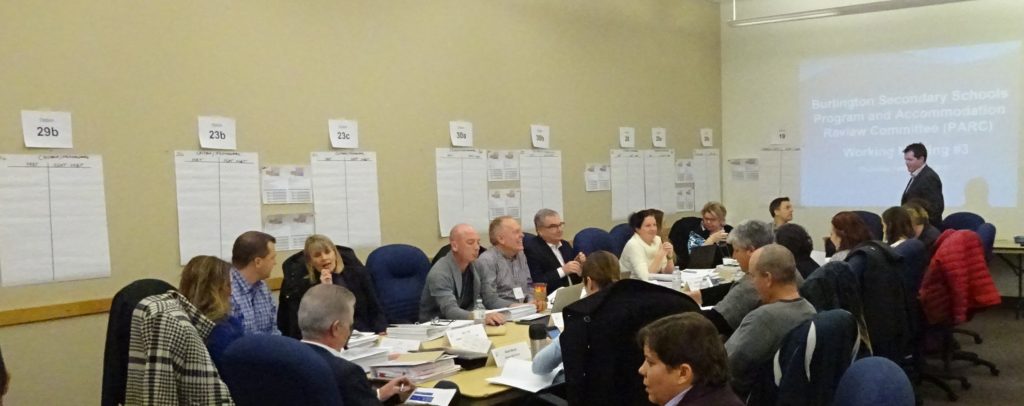 The 14 members of the PARC and their advisors. That committee was created and met on seven different occasions to look at the facts and serve as a communication channel between the Board and the community.
The flow and quality of the information from the Board of Education became suspect quite early in the game – and it didn’t get any better. The quality of the members of the Program Accommodation Review Committee (PARC) surprised the Board of Education staff. These 14 people (two from each high school) were not going to go quietly into the night. The Board Staff came up with 19 options. That climbed to close to 40 which the PARC people whittled down to five.
They were:
Do not close any of the high school – re-work the existing boundaries to balance the high school students more evenly.
or
Close Robert Bateman in June 2018.
or
Close Nelson in June 2018
or
Close Central and Pearson in June 2018
or
Close Lester B. Pearson in June 2018
There are a lot of provisions and conditions attached to each of these closure options. The Gazette published a detailed list of the options CLICK HERE
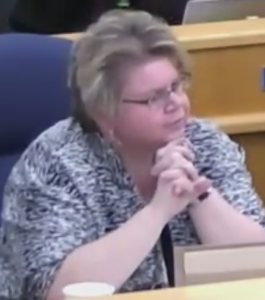 Donna Danielli asked – pleaded – with the PARC members to come up ways to keep all the Burlington high schools open. Donna Danielli, a Milton based Board of Education trustee, sat on the PARC as an advisor. During the last meeting of the PARC she asked, it was really more of a plea, for the PARC members to come up with a way for the Trustees to keep all the schools open.
The process and procedure schedule is as follows:
Wednesday April 26, 2017 – Director’s Final Report will be presented to the Board of Trustees at the Committee of the Whole meeting.
Monday May 8, 2017 (6 pm) – Public Delegation Night.
Thursday May 11 (6 pm) – Public Delegation Night.
Wednesday May 17, 2017 (7 pm) – Board meeting. Final Report to Board of Trustees for “information”.
Wednesday June 7, 2017 (7 pm) – Board meeting. Final Report to Board of Trustees for “decision”.
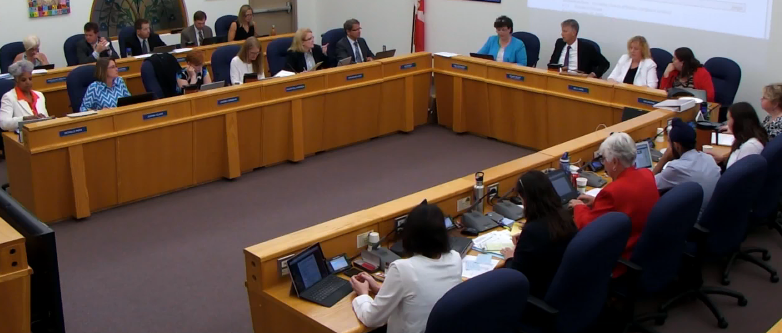 The eleven members of the Halton District school Board will decide how many, if any, of the high schools in Burlington are to be closed in 2018 However, anything that happens from this point forward is in the hands of the trustees – they can do whatever they wish. If they don’t like what they are given they can instruct the staff to take the work they have done so far and rework some of the options.
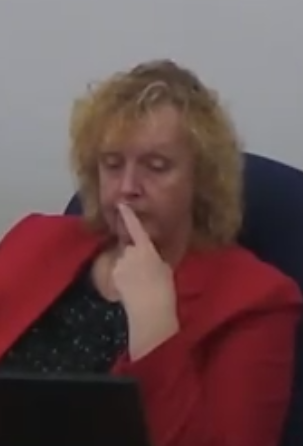 Chair of the Halton District School Board Kelly Amos Halton unfortunately does not have much in the way of leadership at the trustee level. Eight of the 11 woman on the Board have just over two years’ experience. Kelly Amos, an Oakville based trustee, has been close to mute while the PARC meeting were taking place. Many argue that this is what she should have done.
One is pressed to recall a situation where the Chair actually guided her Board. It is a one vote per trustee operation and Burlington has just four of the 11 votes; six are needed for Burlington to keep all its high schools open.
It all comes down to the content of the report Stuart Miller submits.
Will it be a mish-mash of all the data that has come in; will it be based on his core belief that the academic offering is the most important issue or will he consider the role of community in the placement of high schools?
Miller has already said it is not a money issue and he has also said that the Board does not have to close any of the high schools. It was the level of the utilization rates that triggered the Program Accommodation Review. Miller is on record as having said this process should have been done a number of years ago.
 Stuart Miller on the right at a Robotics information session that attracted more than 400 students. Stuart Miller is a passionate defender of the quality of the academic offering his Board offers the students. He wants every school to allow every students to study want they want to study, which is what drives his preference for large schools with student populations of well over 1000.
Miller has been Director of Education for more than a year; he was appointed in September of 2015.
He is a relatively young man who does not appear to have career aspirations that would take him to the Ministry of Education at some point in his career. He is at heart a high school teacher who can recall the first name of most of his past students. It is not unusual to see him out at a student event on a Saturday morning. He is proud of what his Board offers and while Halton doesn’t get the level of funding other boards get Halton has always ranked well on how its students fare in academic standings.
The challenge before Miller this weekend is the biggest he has faced as a senior Board staff member. He has another challenge that will follow right behind the school closing issue and that is the matter of French Immersion classes.
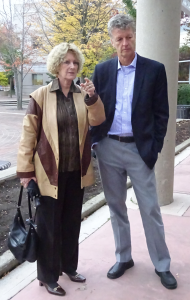 Joey Edwardh, president of Community Development Halton and Stuart Miller Miller is a practical man – he also has a sense of humour. At a recent Board of Education meeting he gave his report entirely in Gaelic – to the astonishment of the Chair. He didn’t give an interpretation of the Gaelic either. So he has a sense of history, heritage and community values.
Is he capable of realizing and understanding that even the very best academic offering is not of much use if it is delivered in an environment that is devoid of the community it takes place in?
Miller does not live in the Region; his home is in the High Park part of Toronto but the bulk of his academic career has been with the Halton Board.
He has listened too many in the community, however there are those that argue he does not hear what they are saying. He is one of the most accessible bureaucrats this reporter has encountered.
For the sake of the people of Burlington one hopes that Stuart Miller took several long walks during the weekend and began to get close to deciding what kind of a Director is he going to be.
 From the left, Ward 6 Councillor Blair Lancaster signing the 20 year $1.3 million naming rights deal with Chris Haber in the Centre. Chris Glenn on the right is pleased with that much cash. The Haber Recreational centre id part of the Hayden high school complex. One hopes that he proves to be better than the past Directors of Education who let things slide so badly that we now face the mess we are dealing with.
Both past trustees and past Directors have a lot to be ashamed about. The creation of Hayden high school, the newest in the city, which is now over crowded – at a 150% plus utilization, may be a decision that kills the downtown core of the city.

 By Pepper Parr By Pepper Parr
April 13th, 2017
BURLINGTON, ON
There are going to be two evenings set aside for delegations to the school board on the matter of the Program Accommodation Review the board is currently conducting.
The plan is to hear 25 delegations each evening with the delegator given five minutes to make their case. Five minutes are allocated for the trustees to ask questions or seek clarification.
Dates and times for both registering to be a delegation and dates on which people will be heard have been published.
At a Parent-school committee meeting at Lester B. Pearson high school earlier in the week there was considerable confusion as to just what the process was going to be for the allocation of the delegation slots.
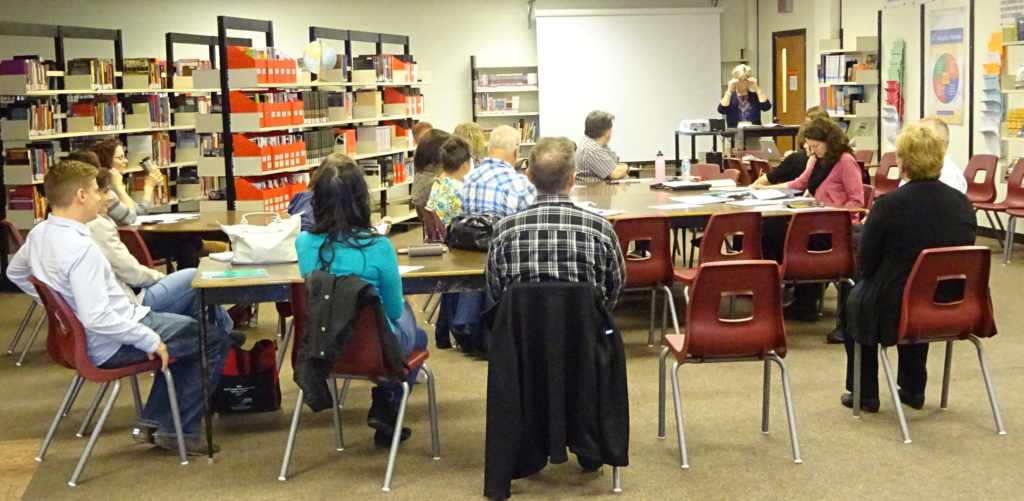 Parents at a Lester B. Pearson high school – parent school meeting. The selection of the delegations is not being done on a “first come – first served” basis.
All the delegation applications are given to a staff member who prepares a list which is then given to the Chair who will determine who speaks and when they speak.
The concern at the Board staff level is that people provide enough information so that the selection of delegations is based on information. If your application to delegate is not clear – expect a phone call from the Board staff member handling the documents. The Board staff are asking delegation applicants to be as detailed as they can.
 The eleven school board trustees will make the final decision on whether or not a high school(s) is to be closed and if yes – which one(s). There has been a view that the Board might want to limit delegations from one of the high schools. The staff member handling the applications is just shuffling paper and passing it on to the Chair of the school board. The staff member would like to ensure that what she passes on has some detail so that the chair can make fair decisions.
There are going to be literally hundreds of parents who will want to delegate and plead with the trustees to not close the school that every member of the family for several generations has attended and that they all love dearly.
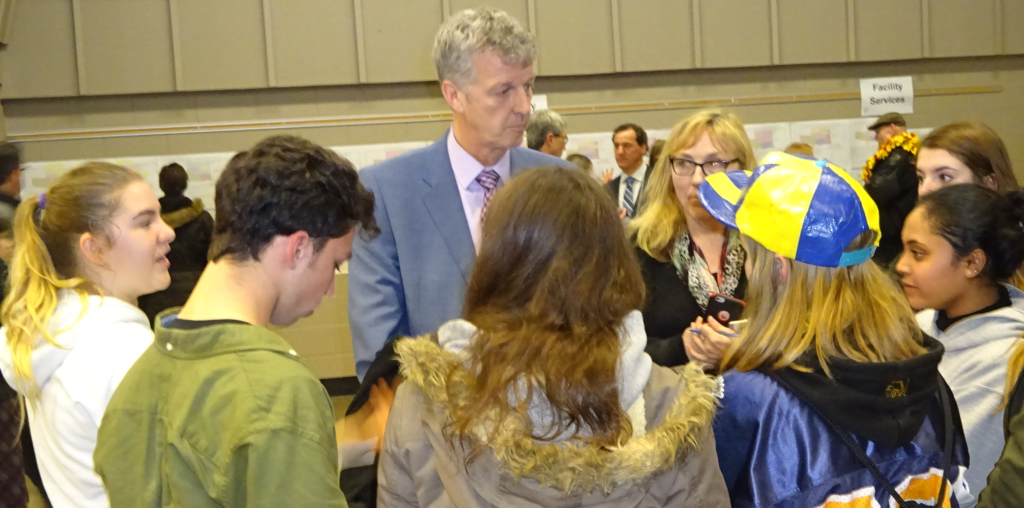 Director of Education Stuart Miller listening to high school students. While such a delegation may make the person speaking feel all fuzzy and warm – it will do little to inform the trustees or the Director of Education.
There are many voices in the community that do not trust the Board of Education to be fair in the allocation of the 50 slots. It is not the Board staff that will be determining who gets to speak – it will be the trustees you elected.
The Gazette has been given to believe that if there are far too many delegation requests to be heard in the two evenings that have been set aside – additional time might be made available.
The desire, as explained to the Gazette, is to give people a chance to make their case so that the Director of Education can make a recommendation that includes what he hears at the delegation meetings and can arrive at a recommendation that includes the views of the parents.
The trustees need to hear viewpoints that are more than an emotional plea.
In fairness to the schools that are under threat of being closed it is vital that they be given an opportunity to delegate fully. One would think that the trustees would look for a way to ensure that each of the four high schools: Central; Bateman; Nelson and Pearson could be guaranteed a minimum number of delegation slots to make their case with the trustees.
And the allocation of those guaranteed slots should be assigned by the members of the The PAR committee who have worked very hard and know the case that is being made for their school extremely well – the Chair must ensure that they be guaranteed time to speak and not be squeezed out by the running of a clock.
There are some fundamental principles of fairness in play here and the trustees need to be extremely sensitive to the anxiousness in their communities.
 Board of Education Chair Kelly Amos: lead in a fair and impartial manner. The Chair of the Board needs to show some leadership and assure the community that they know they were elected to lead and then to do so in a fair and impartial manner.
This is the time for those people deeply concerned about what happens to ensure that the trustees know what you expect of them.
If the trustees fail to more than adequately meet the needs of the parents who have something to say – there will be an opportunity for the voters to show their appreciation in the June 2018 election.

 By Pepper Parr By Pepper Parr
April 12th, 2017
BURLINGTON, ON
They are relentless.
Millions, tens of millions of email like the one below get sent out to lists of email addresses.
When you get one – read the address it came from very very carefully – they are all false, phony messages sent to you in the hope that you just might click on the message.
 Read the address this phony email came from. The name between the < > is the sender – not the Royal Bank. If you don’t recognize the name of the sender – don’t open the email. When you do that they have got a bit of a hook in you and they will slowly try and reel you in to the point where they have enough information to begin stealing your money.
The recipient of this message does not have an account with the Royal Bank
Dear (name erased to protect the recipient)
 When these computer hackers get enough information from you – they can access your bank account and remove funds. During our usual security enhancement protocol, we observed a payment was placed on pending status due to the recent upgrade in our database. In order to receive this payment you are required to verify your account from our secure verification link.
To Receive payment kindly click :
Log on to www.royalbank.com/cgi-bin/rbaccess/rbunxcgi
Remember,RBC Royal Bank is committed to your security and protection. To find out more, take a look at our
Information Security section under Privacy and Security on the Web site.
© Royal Bank of Canada Website, © 1995-2017 All rights reserved.
Banks in Canada do not use email to advise you of any problems with your account.

 By Pepper Parr By Pepper Parr
April 12th, 2017
BURLINGTON, ON
REVISED and CORRECTED
It was a regular Parent School Council meeting at Lester B, Pearson high school where principal Loraine Fedurco was taking the audience through what had been happening at the Board of Education where Staff had put forward a recommendation that, if voted for by the trustees, could result in the closing of the school in June of 2018.
Lester B. Pearson high school, named after a former Prime Minister, is the newest of the four high schools that are named in the five options on closure choices that will go before the trustees later this month. It is also the smallest high school in Burlington. One of the five options is to not close any of the high schools in the city.
 Ward 4 trustee Richelle Papin The School Board trustee Richelle Papin was in attendance – they gave her a rough ride.
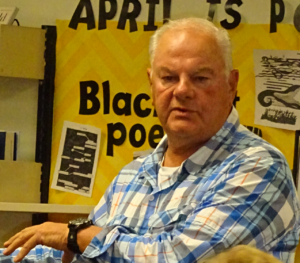 George Ward George Ward, a resident was blunt and direct – are you going to vote to keep this school open – Yes or No.
Papin didn’t give a yes or a no answer – she said she wanted to wait until she had all the evidence.
Ward asked again – he asked a total of five times but never got a direct answer
Papin said she wanted to hear what the delegations had to say and she wanted to read what the Director of Education had to say in his report that will be released April 21st.
Unfortunately for Papin she didn’t have an answer ready for the audience. Their question – are you going to support us – was one that had to be expected.
The difficulty for Papin is that she is also the trustee for Nelson high school and there is amongst the five options now before the Director of Education a recommendation that Nelson be closed.
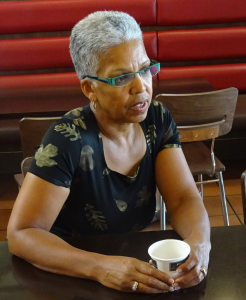 Trustee Papin in a tough spot – two of the four schools that have been named for possible closure are in her ward. Papin is in the very uncomfortable position of having two schools in her ward that could be closed. Tough spot to be in.
This is Papin’s first term as a trustee – it may well be her last. It all depends on what the Director of Education puts forward.

 By Pepper Parr By Pepper Parr
April 10th, 2017
BURLINGTON, ON
The battle lines are being drawn.
Homes in the downtown core got a mail drop recently setting out where Progressive Conservative candidate Jane McKenna stands on the issue of closing high schools in the city.
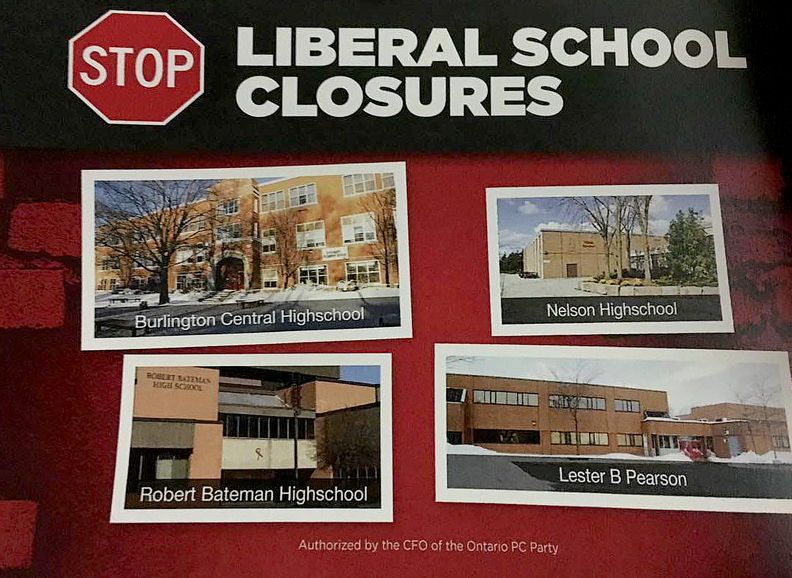 Side 1of a flyer dropped off at homes in Burlington. 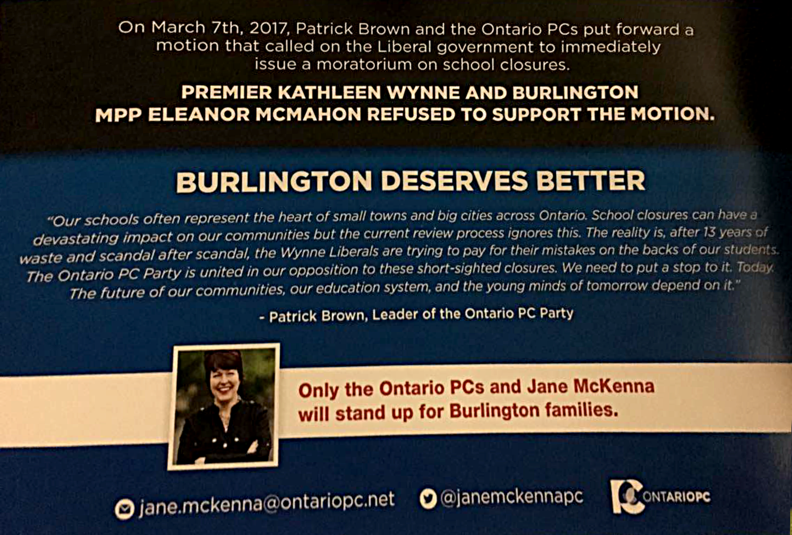 Side 2 of a flyer dropped off at homes in Burlington. City hall may have been reluctant to get involved but the smell of blood in the water has Jane McKenna focusing her efforts on turning minds in ward 2.
The facts need not bother getting in the way – there is an opportunity to exploit and it doesn’t appear it is going to be missed.
There was a debate in the provincial legislature and the Liberal party did vote to take no action at this point in time.
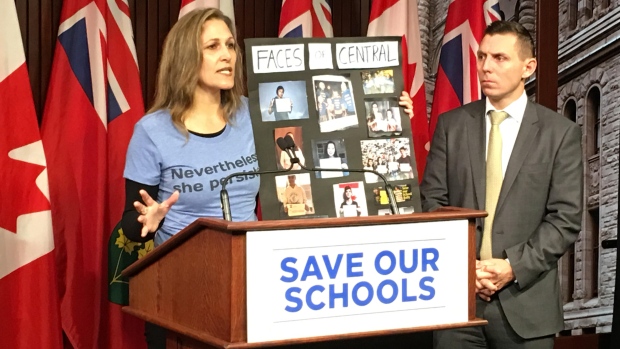 Ward 2 city Councillor Meed Ward who is a member of the Program Accommodation Review Committee took part in a media event at Queen’s Park with Progressive Conservative leader Patrick Brown. Meed Ward has always identified herself at a Liberal in the past. PC leader Pat Brown held a media event the day of that vote with Burlington’s ward 2 city Councillor Marianne Meed Ward at the microphone appealing to the provincial Liberals to do something about the Program Accommodation Review (PAR) taking place in the city.
Meed Ward and most of the parents involved in the school closing issue believe that the PAR process being used is badly flawed and that the quality of the information the school board is feeding the public is both not reliable and subject to frequent changes.
The Program Accommodation Review Committee (PARC) has completed its work and the matter is now in the hands of Board staff who are pulling together the numerous documents that Director of Education Stuart Miller will use in preparing the report he will deliver to the trustees and the public on April 21st.
We are going through a bit of a quiet time while that report goes through what will probably be several drafts before it is placed in the hands of the trustees and the public on April 21st at 6:00 pm; a Friday on the Board of Education’s web site.
All the senior people at the board will have quietly driven out of the Board parking lot and headed for home – no one wants to be around for whatever the backlash to that report is going to be.
The report will get discussed at a school board trustee Committee of the Whole on Wednesday April 26, 2017 starting at 6:00 pm.
Between now and then everyone with any skin in the game will do everything they can to influence the outcome of the debate and discussion that will now take place in front of the 11 school board trustees.
The literature that went out to households in the high school catchment areas across the city might be just the start.
Politics, especially local politics are called a “blood sport” for a reason.
The Burlington Progressive Conservatives are fully funded for the next provincial election. Former city Councillor and Member of Parliament Mike Wallace is running the McKenna election campaign.
Wallace wants and needs to win this campaign if he is to get back into local politics; his eye is believed to be on the office of Mayor for Burlington.

 By Staff By Staff
April 5th, 2017
BURLINGTON, ON
The Halton District School Board has whittled the 30 plus options that were put before the PARC down to five.
The Board set out a rationale for each option and provided maps showing what the boundaries will be for each of the five options
The Gazette has pulled together the five maps along with the rationale and make them available to the public.
Nelson high school closes in June 2018
 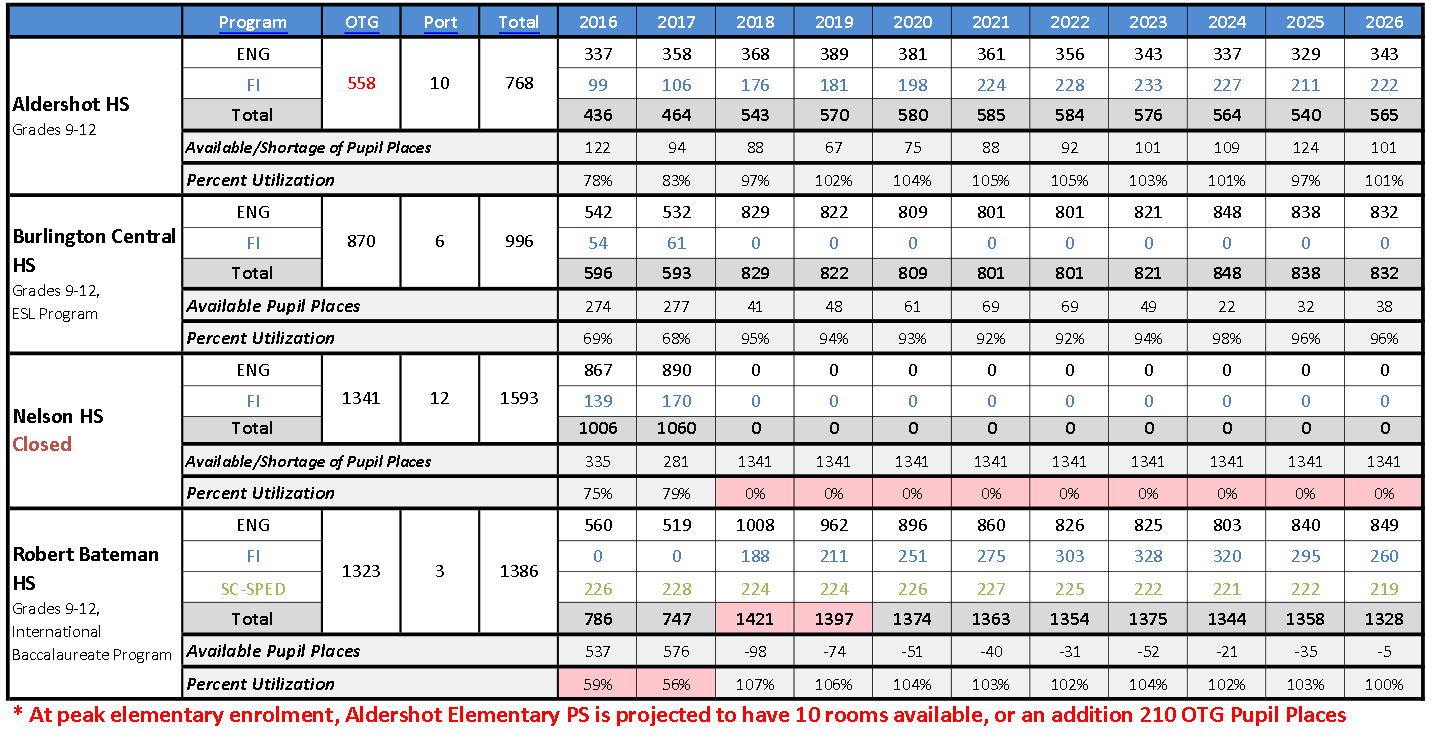 Rationale: Rationale:
To be an English only school.
Burlington Central HS: Catchment expands east to Walker’s Line.
Burlington Central HS: Utilization rates increase to 93% by 2020, then expected to increase.
Nelson HS: Closes in June 2018
Robert Bateman HS: English – catchment expands west to Walker’s Line. FI catchment extends to Guelph Line. (Current Nelson HS catchment)
Robert Bateman HS: FI program added.
Robert Bateman HS: Utilization rates increase to 104% by 2020, then declines4 rationale.
Robert Bateman HS: Closes in June 2018.
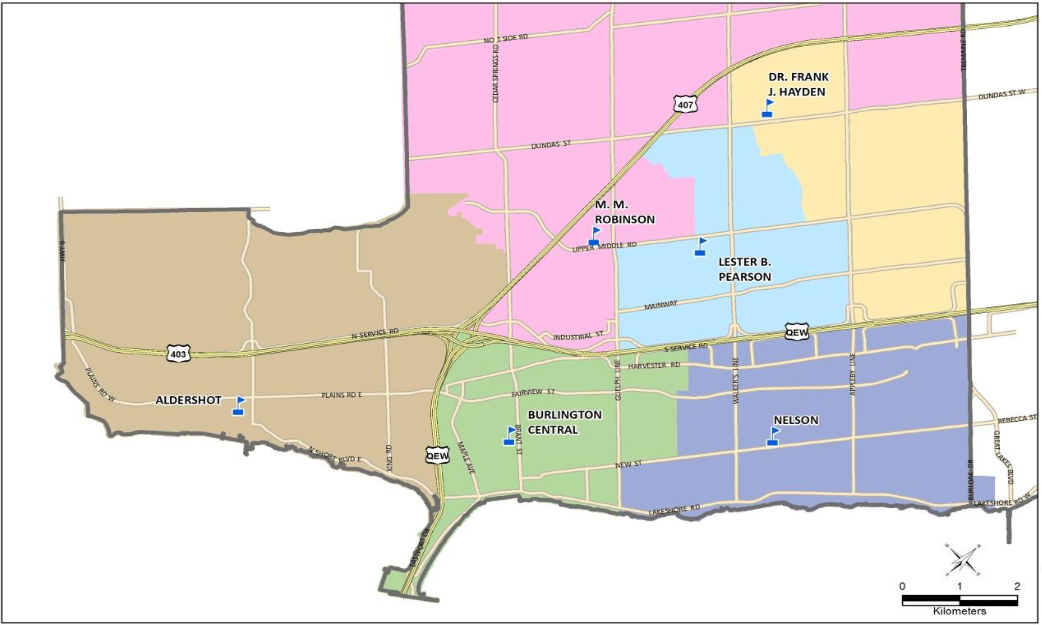 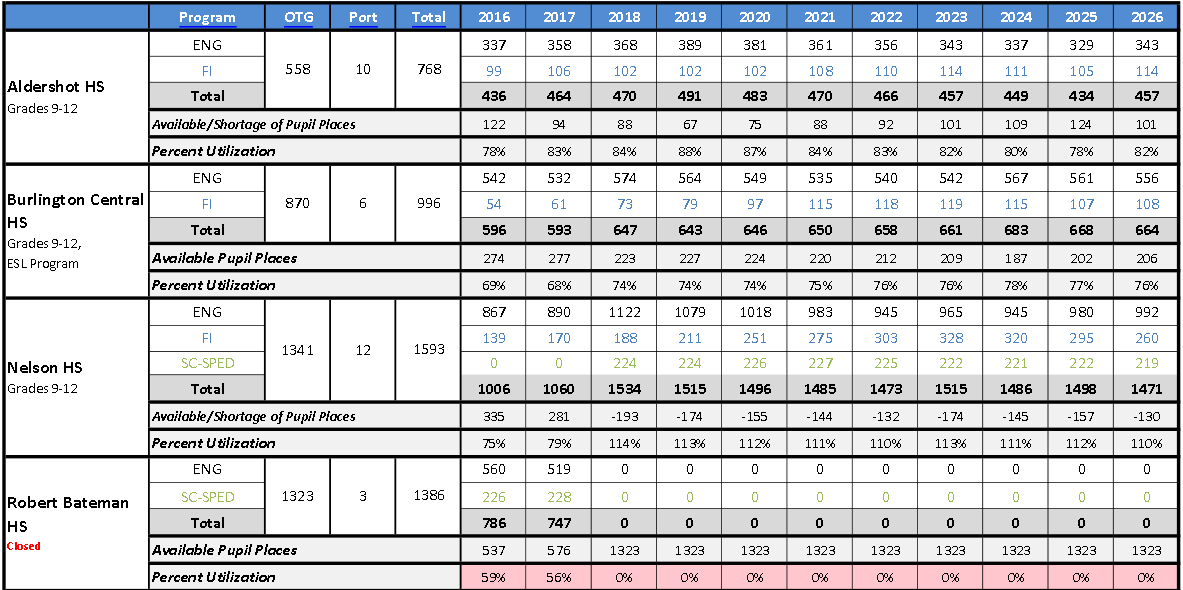 RATIONALE: Staff generated option. RATIONALE: Staff generated option.
Staff modified based on PARC comments:
To create suitable facilities for SC
SPED and Essential at Nelson
Food Service program to be relocated from Robert Bateman HS to Nelson HS
Extend Lester B. Pearson HS catchment to increase enrolments.
ISSUES:
Lester B. Pearson HS to gain the IB program and Gifted Secondary Placement Program.
Low enrolments at Aldershot HS and Burlington Central HS
Low Utilization at M.M. Robinson HS
NOTES
Aldershot HS: Utilization rates increase to 87% by 2020, then expected to decrease.
Aldershot HS: No change to the Aldershot HS catchment. Enrolment is under 500 students.
Burlington Central HS: Boundary expands to include areas east of Guelph Line.
Burlington Central HS: Utilization rates increase to 74% in 2020 and continue to increase until 2024.
Nelson HS: SC
–
SPED and ESS programming (both under SC-SPED) and Food Services added. New facilities to be constructed.
Nelson HS: ENG catchment expands to include Robert Bateman HS.
Nelson HS: Utilization rates expected to increase to 112%, by 2020, then are projected to decline in 2023.
Robert Bateman HS: Closes in June 2018.
M.M. Robinson HS: ENG boundary to expand to include Kilbride PS.
M.M. Robinson HS: Utilization rates remain under 65%
No schools closed – catchment boundaries are revised.
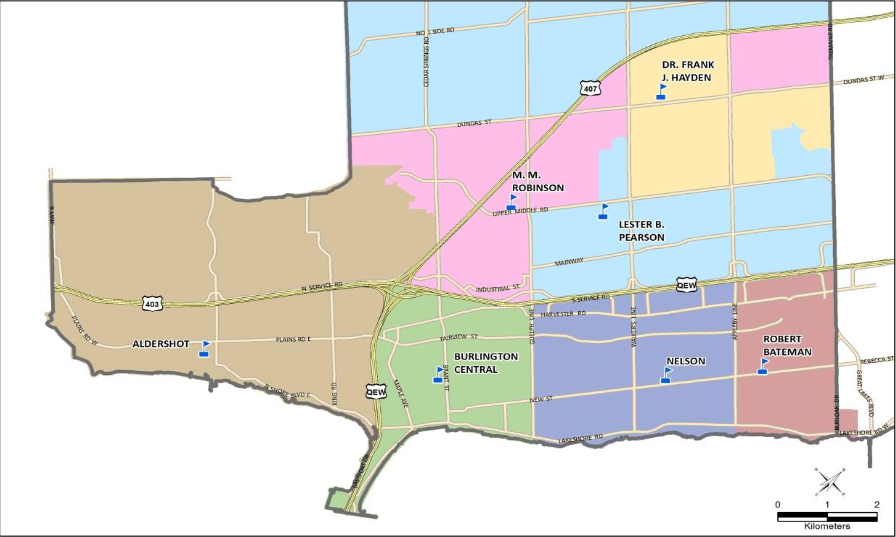 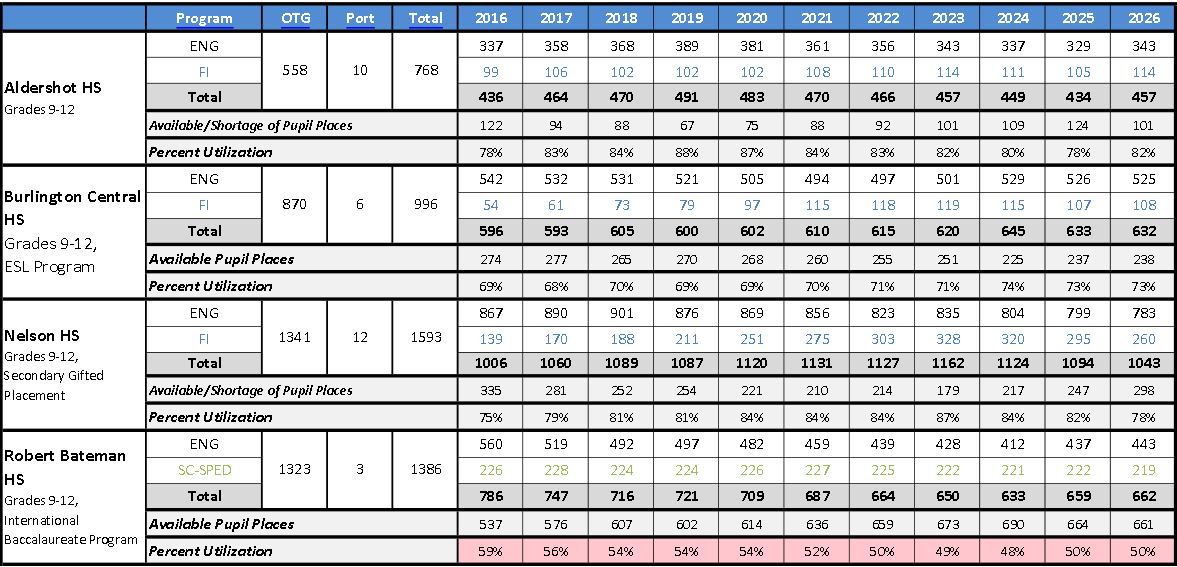 RATIONALE: Staff generated option. RATIONALE: Staff generated option.
Staff modified based on PARC comments:
Removed capping from Dr. Frank J Hayden HS and reduced catchment.
Extend Lester B. Pearson HS catchment to increase enrolments.
ISSUES:
Lester B. Pearson HS to gain the IB program and Gifted Secondary Placements.
Low enrolments at Aldershot HS, Burlington Central SS, Lester B Pearson HS and Robert Bateman HS
Low Utilization at M.M. Robinson HS
NOTES
Aldershot HS: Utilization rates increase to 87% by 2020 , then expected to decrease.
Aldershot HS: No change to the Aldershot HS catchment. Total enrolment is under 500 students.
Burlington Central HS: No change to the Burlington Central HS catchment or enrolments.
Burlington Central HS: Utilization rates increase to 69% in 2020 and continue to increase until 2024.
Nelson HS: No change to the Nelson HS catchment.
Nelson HS: Utilization rates expected to increase to 84%, by 2020, then are projected to decline in 2024.
Robert Bateman HS: No change to the Robert Bateman HS catchment. Enrolment is under 500 English and IB students.
Robert Bateman HS: Utilization rates are expected to decline to below 50% from 2022.
M.M. Robinson HS: ENG boundary to expand to include Florence Mears PS west of Walker’s Line.
M.M. Robinson HS: Utilization rates remain under 65%.
Close Central and Pearson: The original recommendation
 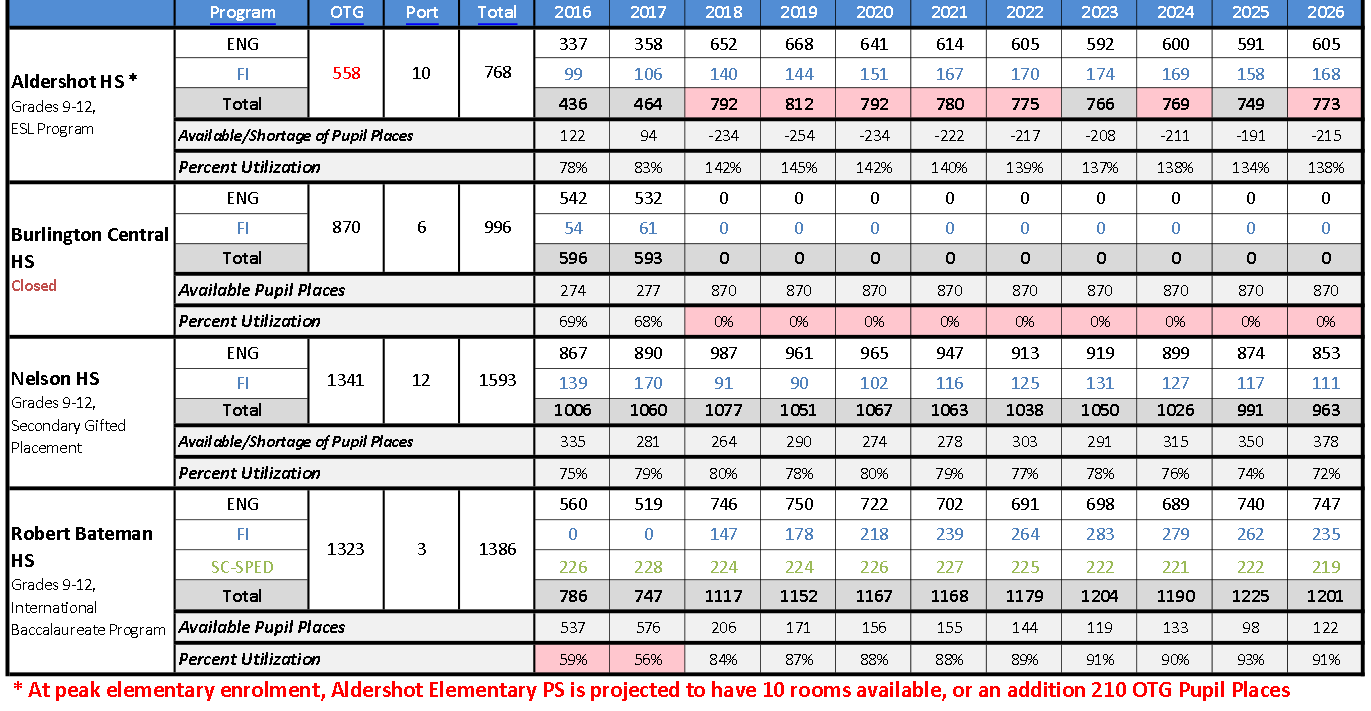 RATIONALE: Director’s Recommendation RATIONALE: Director’s Recommendation
Staff modified based on PARC comments:
ESL Program to Aldershot HS
Specialty programs Robotics to be transferred to Nelson HS.
Transfer empty space from Aldershot Elementary to Aldershot Secondary school
Additional students to Robert Bateman HS catchment
ISSUES:
EXTF program added to M.M. Robinson HS.
FI program added to Robert Bateman HS.
PAR will be required for the Burlington Central elementary communities.
NOTES:
Aldershot HS: Boundary to expand east to Brant St.
Aldershot HS: 210 empty pupil places at Aldershot Elementary PS to be added to the Secondary school OTG. Currently not included in the 558OTG.
Aldershot HS: Utilization rates increase to 142% by 2020, then expected to decrease. Utilization rates will decrease with the addition of available pupil places from the elementary facility.
Burlington Central HS: Closes in June 2018.
Nelson HS: Boundary is to be expanded west to Brant Street.
Nelson HS: Utilization rates increase to 80% by 2020, then expected to decrease.
Robert Bateman HS: ENG boundary expands to include all of the Frontenac PS catchment.
Robert Bateman HS: FI program added and includes students east of Appleby Line and south of Upper Middle Rd and Frontenac PS students
Pearson closes
 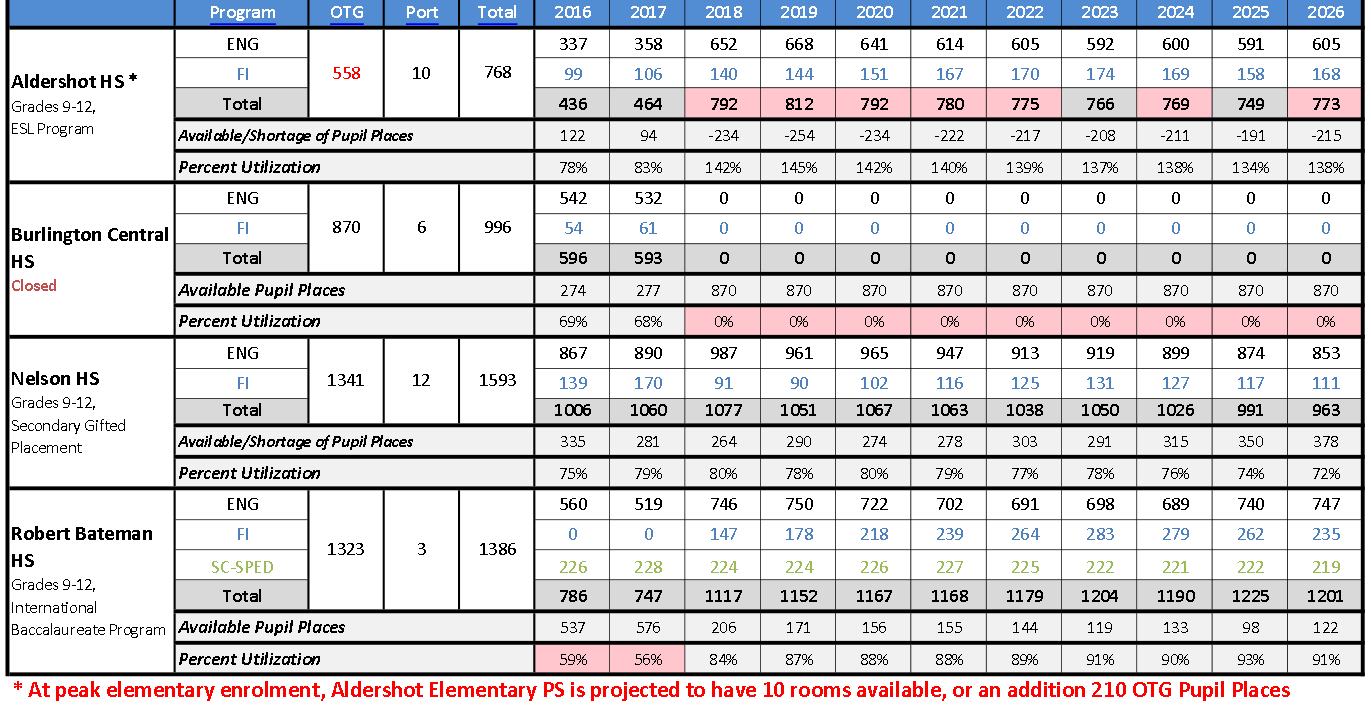 RATIONALE: Based on a PARC Request. Staff modified based on PARC comments: RATIONALE: Based on a PARC Request. Staff modified based on PARC comments:
To balance enrolments north of the QEW.
To create suitable facilities for SC
SPED and Essential at Nelson
–
Food Service program from Robert Bateman HS to Nelson HS
ISSUES:
SC-SPED, ESS programs relocated from Robert Bateman HS to Nelson HS.
International Baccalaureate (IB) program relocated from Robert Bateman HS to Burlington Central HS.
FI program removed from Dr. Frank J. Hayden SS.
Nelson HS exceeds Total Capacity.
Low enrolments at Aldershot HS
EXTF program added to M.M. Robinson HS.
NOTES:
Aldershot HS: Utilization rates increase to 87% by 2020, then expected to decrease.
Aldershot HS: No change to the Aldershot HS catchment. Total enrolment is under 500 students.
Burlington Central HS: Boundary expands to include areas east of Guelph Line.
Burlington Central HS: International Baccalaureate program to be added.
Burlington Central HS: Utilization rates increase to 90% in 2020 and continue to increase until 2024.
Nelson HS: SC-SPED and ESS programming (both under SC-SPED) and Food Services added. New Facilities to be constructed.

 By Pepper Parr By Pepper Parr
April 5th, 2017
BURLINGTON, ON
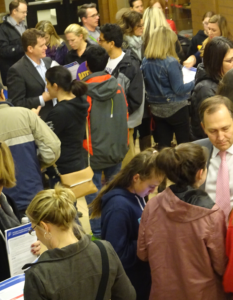 Parents at a public meting were the details for each of the school closure options were made available. Parents with high school students are getting a bit of a break from the work that was done by the Program Accommodation Review Committee (PARC). The members of that committee have completed their work knowing that they did everything they could to dig out much needed information and whittled a list of more than 30 possible options down to five.
Those five are:
Robert Bateman high school closes in June 2018.
Nelson high school closes in June 2018
No schools closed – catchment boundaries are revised.
Central and Pearson high schools are closed in June 2018
Pearson high school closes in June 2018
The next municipal election, at which school board trustees will stand for election is October 2018. The provincial government is up for re-election on June xx 2018.
The schedule going forward is:
Chair of the PARC gives his report to the Director of Education (The Gazette has yet to be given a date for the completion of this report.)
Friday April 21, 2017 – Director’s Final Report released online at www.hdsb.ca in the agenda package for Committee of the Whole.
Wednesday April 26, 2017 (6 pm) – Director’s Final Report will be presented to the Board of Trustees at the Committee of the Whole meeting.
Location: J.W. Singleton Centre (2050 Guelph Line, Burlington). This meeting will be live-streamed on the Board website. If additional audience capacity is required, it will be available at M.M. Robinson High School (2425 Upper Middle Road, Studio Theatre).
Monday May 8, 2017 (6 pm) – Public Delegation Night. These evenings will be live-streamed on the Board website.
Location: J.W. Singleton Centre (2050 Guelph Line). Seating priority in the Boardroom will be given to delegates. If additional audience capacity is required, it will be available at M.M. Robinson High School (2425 Upper Middle Road, Studio Theatre). Monday, April 17, 2017 – Is the first date to submit online Delegation Request Forms for the May 8 Delegation Night.
Thursday May 11 (6 pm) – Public Delegation Night. These evenings will be live-streamed on the Board website.
Location: J.W. Singleton Centre (2050 Guelph Line). Seating priority in the Boardroom will be given to delegates. If additional audience capacity is required, it will be available at M.M. Robinson High School (2425 Upper Middle Road, Studio Theatre). Thursday, April 20, 2017 is the first date to submit online Delegation Request Form for the May 11 Delegation Night.
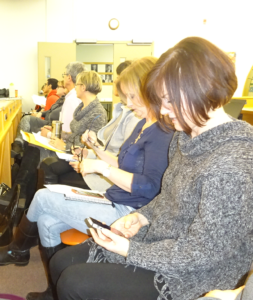 Parents listening to the PARC meetings. Central high school parents had a team at these meetings every occasion. Wednesday May 17, 2017 (7 pm) – Board meeting. Final Report to Board of Trustees for “information”. Location: J.W. Singleton Centre (2050 Guelph Line). If additional audience capacity is required, it will be available at M.M. Robinson High School (2425 Upper Middle Road, Studio Theatre).
Wednesday June 7, 2017 (7 pm) – Board meeting. Final Report to Board of Trustees for “decision”. Location: J.W. Singleton Centre (2050 Guelph Line). If additional audience capacity is required, it will be available at M.M. Robinson High School (2425 Upper Middle Road, Studio Theatre).
Maps of the school boundaries and the rationale for each option is set out HERE.

 By Pepper Parr By Pepper Parr
April 5, 2017
BURLINGTON, ON
City council had decided they were going to keep a barge pole length between what they do and what the Public school board has to do.
These two organizations –both vital to the smooth operation and functioning of the city are far apart when it comes to working together on joint issues. The city and the school board are so far apart that they don’t even meet on a formal basis.
The Halton District Regional Police make a presentation to the city; the Library makes a presentation to the city. When the Board of Education meets with the city it is usually at the staff level and then it usually boils down to a turf war. These guys tend not to play golf with each other.
Everyone in the city is the lesser for that political failure.
When the Board of Education told its trustees that it believed it was necessary to close two high schools (that was one of 19 options the School Board staff had considered) City council seemed to be hoping that the matter would stay at the school board level – let them deal with the inevitable political fallout.
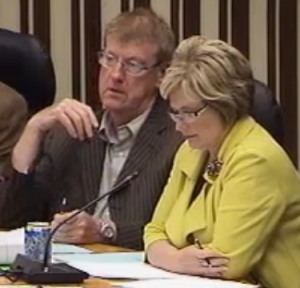 Councillors Sharman and Lancaster were te only two who wanted the city to write a letter to the Minister of Education to halt the Program Accommodation Review the school board was undertaking. And it seemed to be working out – that was until Ward 5 Councillor Paul Sharman asked Council to waive the advance notice of a motion rule and debate his motion that the city write the Ministry of Education asking for an immediate halt to the school closing process now in place to consider the closing of one and perhaps two of the seven high schools in the city.
It has become the hottest political potato the city has faced in a decade.
There was considerable discussion and debate on whether city council was going to let the Sharman motion come forward. Eventually they did on a 5 for, 2 against vote.
One of the negative votes was cast by Ward 2 city Councillor Marianne Meed Ward who argued that it was too late for the city to have any impact on the decision.
Meed Ward said: The moment for the city to show some leadership passed when city council chose to appoint the city manager to the PARC instead of the Mayor and then not give the city manager anything in the way of a mandate. “That ship has sailed” she said.
The motion was to ask that the city write the provincial government and ask that there be an immediate halt to the school closing process now taking place.
Council agreed to allow the motion to proceed which brought Denise Davey to the podium who was given permission to delegate.
She said:
As I wrote in my column in The Hamilton Spectator, this has been an extremely difficult and emotionally draining few months for thousands of parents across the city. We’ve been pulled into a process that we knew nothing about and it’s been a steep learning curve trying to figure it all out.
In addition to trying to sift through a maze of information, we’ve had to deal with ineffective public information sessions where we had no voices and a tedious online survey.
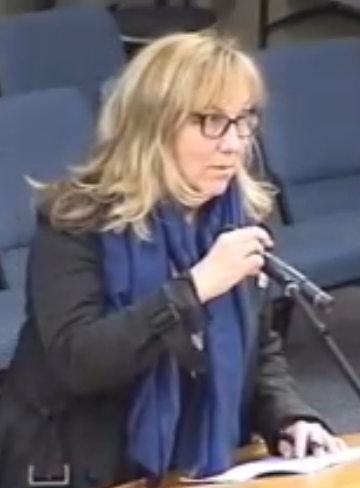 Delegator Denise Davey My worry is that that flawed process and that misinformation that’s been floated around is leading us in the wrong direction and my position – and the reason I approached Paul Sharman – is that I believe Burlington city council needs to take a leadership role.
This is your city and the closure of any school will have an impact on the social and economic fabric of the entire community.
I am not asking that you take a stand around which school to close but simply that you support Councillor Sharman’s motion to suspend the process immediately so that in the end the right decision will be made.
I want to offer an example of how problematic this process has been and why it needs to be suspended, namely, that the data and information being thrown out to the public about Bateman school has been seriously misrepresented.
Shortly after this point Committee chair Meed Ward cautioned Davey that she was straying from the subject being debated.
Davey pressed on and was cautioned a second time – she was determined to get the Bateman high school plea on the record.
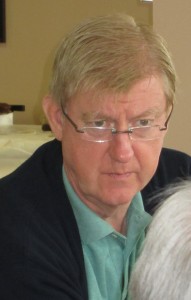 Councillor brought in a “walk on” motion to have the city write a letter to the province asking that the Program Accommodation Review in Burlington be halted. Sharman then began to explain what he was hearing from his constituents. He said he had been asked to help find corporations that might help fund keeping the high schools open. He didn’t mention any specific corporations and asked council to support his request that the provincial government be asked to immediately halt the school closing process in Burlington.
Ward 3 Councillor John Taylor, the longest serving member of Council, joined the debate. He didn’t support letting the motion get to the floor of council and he wasn’t going to support the motion either.
He then went into what was pretty close to a tirade about party politics getting into the debate.
He did however bring some background and wisdom when he explained that the “baby boomers” – those born just after the end of the Second World War, have changed everything they touched as it grew and evolved.
They changed the way education was delivered; we were building elementary schools all over the place and then high schools, and then then universities.
The woman who worked in factories during the war returned to their homes, married and had children. Three to four children was not unusual. Those children needed schools. They were the boomers and as they grew families found they needed two incomes to pay for the housing they wanted.
Taylor asked his colleagues why anyone was surprised that we face this problem today. It has been in the making for more than fifty years. When dozens of elementary schools were closed it should have been no surprise that at some point high schools would have to be closed as well.
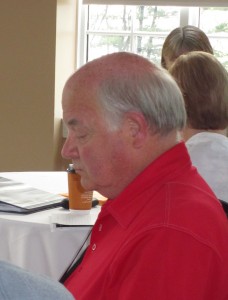 Councillor Taylor gave Council members a broad stroke picture of what they were dealing with. Taylor added that the next phase the boomers are going to impact is the building of hospitals and nursing homes to take care of the boomers who are now aging.
To add to it all Taylor pointed out that advances in medicine have us living longer.
We have to do something about this problem – it can be avoided, he added.
Ward 4 Councillor Jack Dennison said that this was a provincial government and Board of Education trustee problem – it is not a city problem. He saw no point in the city making a plea to the provincial government.
Ward 6 Councillor Blair Lancaster said that more and more parents were asking her to become involved. “None of the schools that are being recommended for closure are in my ward but some of the students are”, she said.
And added that she too felt the process was flawed and that while she wasn’t comfortable with interfering she was very concerned about the problem of the quality of the data that was being used to make a decision.
“This is an important decision and I want the best data available to make that decision”, she said. Lancaster added: “If an appeal to the provincial government can get us a time out and let us take a step back and get better data and do it right then I am for sending the letter.”
Meed Ward said she did not believe the province would intercede for one Board of Education and asking it to do so was “irresponsible and inappropriate”.
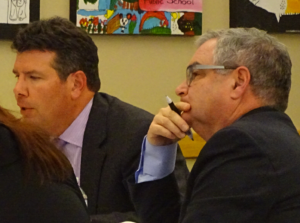 City manager James Ridge, on the right, with PARC Chair Scot Podrebarac. Ridge said very little during the meetings – he wasn’t given a mandate other than to attend the meetings. “Council squandered its opportunity to lead on this. There was an opportunity to send an elected member – we didn’t do that and we didn’t give the person we did send anything in the way of a mandate.”
Having “squandered” the opportunity to lead Meed Ward said the city could now join the other organizations in asking the province to put a moratorium in place across the problem. ROMA – the Rural Ontario Municipal Association has done a lot of research that is very well documented – we could join their plea. AMO, the Association of Municipalities in Ontario has made comments however they have not asked for a moratorium.
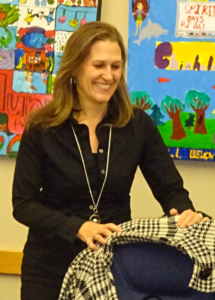 Meed Ward is troubled by the message city Councillors are sending constituents, particularly parents of Central and Pearson high school students. Meed Ward said she is “troubled” with the kind of message is this council sending when it said up and down that it was not going to get involved but now we have council members who have schools that might be closed in their wards and want the city to do something when the opportunity to do anything has passed.
What message does this council send to the parents of Central and Pearson? that we did not value their schools when they were subject to closure but now that other schools have been named we want to interfere? This is both inappropriate and offensive.
During the discussion the Mayor mentioned that he had a conversation earlier in the day with the Minister of Education – but didn’t say what words were exchanged.

 By Pepper Parr By Pepper Parr
April 4TH, 2017
BURLINGTON, ON
How does one go about the process of giving their parents into some form of care when they can no longer fully care for themselves?
The parents tend to resist this change in their lives – to a considerable degree because they don’t know enough about this next phase of their lives.
 Marion Goard, came up with the idea for the event. she has been nominated as one of Burlington’s BEST Marion Goard, a Burlington real estate agent went through this process with her parents and found it emotionally exhausting. It was clear to her however that in her situation changes had to be made.
Where to go for information? That’s when Goard found that there really wasn’t a single place with all the information needed. There were all kinds of vendors with their offerings but that meant travelling from possible location to yet another possible location.
That is when Goard came up with the idea of gathering all the service providers and the vendors and the social agencies in one location and inviting people to attend and learn as much as they could.
The Housing Options For Seniors Event was born
 Here is the list of organizations who are going to be at the Monday April 10th event being held at the Holiday Inn. Here is the list of organizations who are going to be at the Monday April 10th event being held at the Holiday Inn.
Burlington Age Friendly Seniors Council – Housing Committee
Burlington Gardens Retirement Residence
CARP, Halton Chapter (Canadian Association for Retired Persons)
Chartwell – Christopher Terrace Retirement Residence
Chartwell – Martha’s Landing Retirement Residence
Egality
Estate Concierge
Hearthstone by the Lake
Halton Heart to Home Meals
Heritage Place
Home Equity Bank – Reverse Mortgages
Home Share
Lakeshore Place Retirement Residence
LaSalle Park Retirement Community by Signature
Neat Spaces
Organize Me
Park Avenue Manor
Pearl & Pine Retirement by Signature
Retire-at-Home Services
RBC Royal Bank
Revera Appleby Place
Sell ‘n STAY
Sunrise of Burlington
The Gardens by Maranatha
The Village of Tansley Woods (Schlegal)
The Williamsburg Uptown Seniors Living
That is an impressive collection of people who can help and organizations that have services that might work for you and your parents.
A web site was created with a form people could use to register.
That’s when the problems began to occur.
“Everyone I talked to” said Goard “thought it was a great idea – but the registrations aren’t all that great.”
It is a very good idea and worth a visit even if you are only going to look around and kick some tires.
Registration isn’t vital but Goard would like an idea as to how many people to expect. You can register at: https://www.mariongoard.ca/seniors/housing-options-for-seniors-event.aspx

 By Staff By Staff
April 3rd, 2017
BURLINGTON, ON
 Environment Canada has issued a Special Weather Statement that forecasts rainfall depths of 20-30 mm in our region, overnight and into the day Tuesday. Environment Canada has issued a Special Weather Statement that forecasts rainfall depths of 20-30 mm in our region, overnight and into the day Tuesday.
Rain is also forecast from Wednesday through Friday, with more significant rainfall potential Thursday.
 Our forests aren’t this green yet – but the flow of water is what we are seeing now with the Spring rains. Following recent rains last week, flows are still elevated and soils are wet. As a result of the forecasted rainfall, watercourses may rise rapidly. Banks may be slippery and currents may be strong. Local streams and rivers may become dangerous, particularly in the vicinity of culverts and bridges.
Widespread flooding is not anticipated, however fast flowing water and flooding of low lying areas and natural floodplains may be expected.
Conservation Halton is asking all residents and children to stay away from all watercourses and structures such as bridges, culverts and dams. Elevated water levels, fast flowing water, and slippery conditions along stream banks continue to make these locations extremely dangerous. Please alert children in your care of these imminent dangers.
This Watershed Conditions Statement – Water Safety will be in effect through Sunday April 9th, 2017. Conservation Halton will continue to monitor stream and weather conditions and will provide updates as required.

 By James Smith By James Smith
April 2, 2017
BURLINGTON, ON
The next few months will be difficult for many Burlington parents and students as the Public Board decides the future of several schools. This issue is hardly new to Burlington or Halton, the phenomenon of is being played out throughout Ontario, Canada and North America. For example, Hamilton has closed 14 schools since 2003. Shifting demographics call for creative solutions. Some change is coming to Burlington Schools, what that change will look like is far from determined at this point.
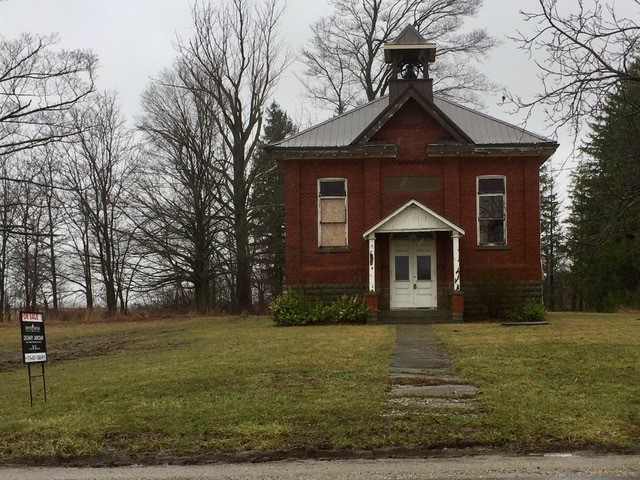 While Burlington’s high schools are not quite this old – these old country schools have disappeared and been re-purposed. In the past, boards have taken the relatively easy route (if closing a school and the ensuring protests they cause can be called easy) when a school is determined to be redundant; they have applied to municipality for re-zoning, then sell the land to the highest bidder. South East Burlington in 1987, when we moved there, had two separate schools, one high school and five public schools within walking distance. Soon both Elizabeth Gardens and Breckon Schools were closed and St Patrick School, the school our kids attended, hung on by its fingernails. At one point only having 75 students!
Having fought hard to keep our local school, I understand what parents are now going through in their attempt to keep a local school. In our case we had a little bit of luck on our side, many of the original empty-nester home owners were selling to families with a couple of kids, so more children were moving into the neighbourhood. More importantly, the former Shell refinery lands west of Burloak, north of New Street meant expanded enrollment significantly. Neither new development nor is intensification is likely going to be an answer to expand enrollment for the schools at risk. The challenge now is for citizens who’s neighbourhood schools face closure, to transition from protest to vision.
Once the decision to close a school has been made, the challenge is to question some deeply held preconceptions; no easy task. The first preconception parents especially need to rid themselves of is the myth of the local school, especially when it comes to a high schools. Local schools, the kind that parents will often define as those as “within walking distance” are more and more not places children walk to. Sure some kids walk, but a significant number of children of all ages are now chauffeured to and from school. One just has to look at the infrastructure put in place to accommodate the pick-up delivery of children in cars. Passing by a school at opening or dismissal, makes one pine to be at the Mall the last weekend before Christmas by contrast. How do local traffic jams add to a community?
Many will talk about the loss of so called open space. Schools often have rather than open space something more akin to a green deserts surrounding the school building. Rarely used manicured lawns, a landscape design element left over from the plan books of Victorian through post war planners that serves little or no purpose; we’re just used to having them. We are used to seeing these areas with nothing there, so we want to keep these green dead zones. The green deserts surrounding all schools, but especially those to be closed, are resources that presently goes wasted. Overcoming these and other preconceptions and understanding the opportunity in school closures is a big and difficult first step. I have no illusion this will be an easy process to undertake, but citizens need to be ready to embrace this change, even reluctantly.
Once the decision has been made to close a school; who best to plan and execute the redevelopment? As stated the old model was a quick rezoning to Single Family Residential, and sell twenty or 30 residential lots to the highest bidder. While the “take the money and run” approach has served the board in the past, times have changed. Given the time and effort of those who have participated in the PARC exercise have demonstrated, and the controversial nature of the decision to close schools, the Board owe the communities and the city a more inclusive re-visioning exercise.
The board of education, by ownership and necessity must be a partner in the process, and realize most of the financial return, but the lead should be taken by the city of Burlington as the city will have to manage the results of the process. I’m rarely a proponent of the 3P model, but in this case I feel a public private partnership is the best way to maximize the return to the board and the city in developing these assets.
Did I say the city? By the city I don’t mean the politicians nor the planning department. As professional and well meaning as city planners may be, this exercise should be taken up by an outside urban planning firm who doesn’t develop and plan track housing. Preclude those firms with a history of developing planning with, and for, the city of Burlington should also be a condition. In other words, an open competition rather than one from the usual suspects. One consideration would be to fund a competition where three semi finalist firms are paid to work-up general, order of magnitude proposals. This way citizens can wade in on what firm’s vision is in the best interest of the the city at large.
In such a process the city’s role should be limited to setting the general goals and parameters. These guidelines should be as loose as possible to allow the bidding firms as much creative leeway as possible. By awaiting proposals from the winning planning firm prior to changing the zoning of former school property, the city can avoid the mistake of regulation that limits development of a novel proposal. Interesting creative uses shouldn’t be precluded from the beginning due to zoning constraints. Plan, then zone. Part of any redevelopment should include re-purposing some or all of the existing school buildings wherever practical, and the development of the site of community amenity assets should be based on input from the neighbours and citizens in general
Many people find the idea of giving up on what they see as “their school” surrender. Many will feel at this point surrender is premature. Change is likely coming. The best way to prepare for change is to start considering and examine one’s prejudices and to start to imagine what the second best alternative might be. Burlington might be a better place as a result of this kind of exercise.
James Smith is a is a former resident of Burlington and is a contract Designer, who includes Phillip H Carter Architect and Planning as one of his clients.

 By Staff By Staff
March 30th, 2017
BURLINGTON, ON
The Toronto-Dominion Friends of the Environment Foundation is sending the city a cheque for $20,000 to enhance the construction of a new community garden in Ireland Park. Construction of the new garden will begin this fall and will open in spring 2018. The garden will include 36 ground based plots and 3 raised accessible plots.
The city has come a long way since June of 2011 when Amy Schnurr of Burlington Green and Michelle Bennett stood as a tag team before city council trying to convince them to put up 15% of the cost of opening the first city based community garden.
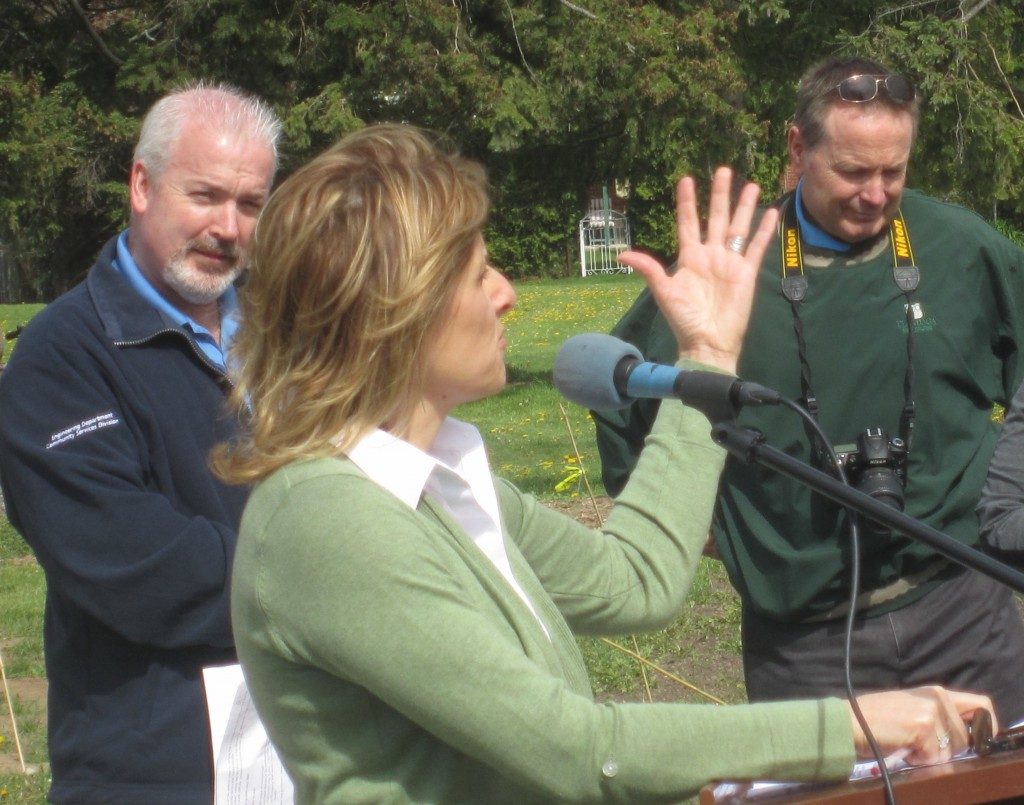 Amy Schnurr at the opening of the first community Garden. Former city general manager Scott Stewart on the left and Rob Peachy realizing that it was Schnurr and Burlington Green that got the city into community gardens. Council wasn’t all that keen on the idea but they couldn’t get away from the two women; they were relentless.
They prevailed and the community garden opened to some fanfare and has grown to the point where there are now four such gardens.
Construction of the new garden will begin this fall and will open in spring 2018. The garden will include 36 ground based plots and 3 raised accessible plots.
Funding will be used to expand accessible garden plots and accessible pathways throughout half of the community garden. These pathways will use wild thyme—a drought-tolerant, pollinator-friendly ground-cover with reinforced turf mesh—rather than wood chips. This will result in an even, stable, accessible surface, allowing people with limited mobility equal opportunity to visit more areas of the community garden and interact with the other gardeners.
The grant will contribute to the cost of an accessible garden shed, an accessible picnic table and three raised, accessible garden plots.
A perennial garden will be planted around a one-metre border outside the garden fence to attract bees and add flowers to the area. TD FEF staff will be asked to help plant the perennial garden as part of TD’s staff volunteer program.
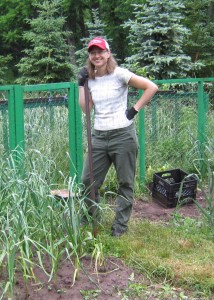 Michelle Bennett – talked the city out of $11,000 + and created a network of community gardens. The city has four community gardens with 126 plots in total for 2017:
• Amherst Park
• Central Park
• Francis Road Bikeway
• Maple Park.
This year’s planting season will run from May 1 to Oct. 22, 2017. All plots have been assigned for this season.
The cost to rent a plot for the season is $50. Water, soil and compost are supplied and all plots have full sun.
Community garden applications are available online at www.burlington.ca/communitygardens, the Burlington Seniors’ Centre, or City Hall, 426 Brant St., at the Service Burlington counter. Completed applications are accepted until Nov. 30, 2017 for the 2018 planting season. Plots at all five gardens will be allocated by lottery at the close of the application period.

 By Pepper Parr By Pepper Parr
March 29, 2017
BURLINGTON, ON
What was originally planned as a two meeting consultation ended its seventh meeting with several of the 14 participants not certain they had finished the job they set out do – which for many was to ensure that their school did not close and for most to do everything they could to not close any schools.
There were some hard truths to be dealt with – there are 1800 plus secondary classroom seats empty and 3000 + elementary classroom seats that are not being filled.
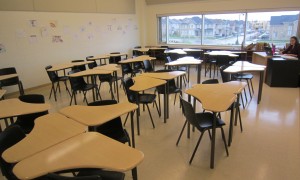 Empty classroom seats – 1800 + at the secondary level and 3000 + at the elementary level. Unsustainable. The problem was twofold – too many empty seats and catchment area boundaries that did not match well enough with the student population
It was during those conversations that the gap between the thinking the Board of Education does and the thinking the parents do – most of whom had strong private sector backgrounds, became painfully evident.
In thanking the 14 PARC participants Director of Education Stuart Miller was both positive and effusive. He had learned far more than he expected to learn and was much more aware of where the school board was failing to communicate effectively with parents.
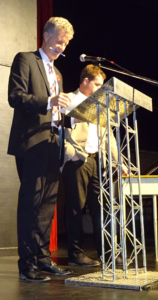 Director of Education Stuart Miller Miller mentioned how complex running an education system is and touched upon the acronyms that are used to describe the numerous programs that are offered to students. He added that the board knew the education side of the problem and the parents knew the community side of the problem and that the space between the two was much wider than he expected.
If anything comes out of this PARC exercise it is that there is a lot of work to be done by the board to get its story out to the community. Miller has to be given credit for that realization – now he has to find a way to improve that communication and accept that trustees cannot be expected to do all of it.
The options the Board has to deal with is to close one high school or two high schools or try really hard to find a way to not close any of the high schools.
The hard reality is that Burlington no longer has as many families as it once had – and there are nowhere near the number of young people being fed into the educational system
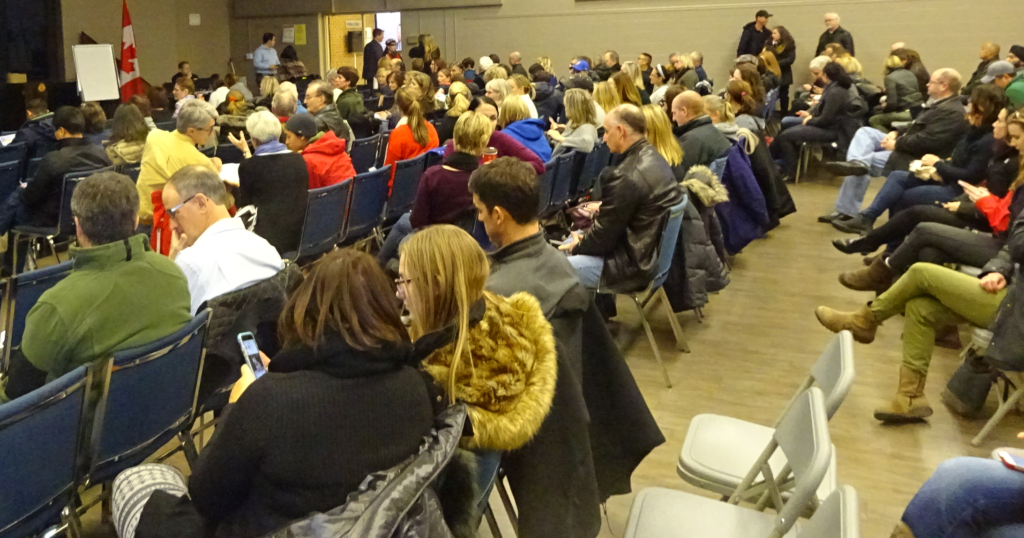 The Director of Education admits that the Board has not managed to communicate effectively with the parents – the PARC process taught him that much. How does he change that dynamic? The problem is now in the hands of the Board staff who have to write reports that will go to the trustees who will then make the final decision – which will be on June 7th
The school year ends June 29th – there are a lot of educators who will want to get out of town real fast – the prospects for keeping all the schools open do not look that good.

 By Staff By Staff
March 28th, 2017
BURLINGTON, ON
– It’s cliché but if it sounds too good to be true it likely is –
It’s Fraud Prevention Month and the Halton Regional Police Service (HRPS) announces its final scheduled Fraud of the Week: Inheritance and Lottery Scams.
The police have focused their public education on fraud and the damage it does to gullible people; usually older people who are not fully aware of what can be done to them via the internet.
 Inheritance and lottery scams typically target older individuals who do not use online banking services. This enables fraudsters to hijack victims’ bank accounts for money laundering with less likelihood of them noticing. Inheritance and lottery scams typically target older individuals who do not use online banking services. This enables fraudsters to hijack victims’ bank accounts for money laundering with less likelihood of them noticing.
According to the Canadian Anti-Fraud Centre, scammers will send up to three million fraudulent letters or emails at a time. The notifications are sent to people around the world and, generally, close to 100,000 people respond. Many victims lose between $20 and $30, but some lose as much as $250,000.
In a typical inheritance scam, an older person receives an email or letter claiming that they are eligible to collect an inheritance. To receive the inheritance, they have a set period of time, usually about 14 days, to respond and provide their contact information by email. Those who reply go on to receive calls and emails from the fraudsters as well as a form requesting personal information.
Shortly thereafter, a cheque for more than a thousand dollars arrives in the mail. To receive the inheritance, victims are asked to cash the cheque and transfer a larger amount of money than the original cheque is worth to the holder of the inheritance. Days later the victim learns that the cheque is fraudulent and they are out the money they transferred.
 In a lottery scam, potential victims are contacted by an email, phone call, text message or pop up screen on their computer. They are advised that they have won a lottery or sweepstakes. Prior to receiving the prize, however, victims are required to pay taxes, duties or other administrative fees. Once the funds are sent, the victim never receives the prize or is sent an alternate prize than they were promised. In a lottery scam, potential victims are contacted by an email, phone call, text message or pop up screen on their computer. They are advised that they have won a lottery or sweepstakes. Prior to receiving the prize, however, victims are required to pay taxes, duties or other administrative fees. Once the funds are sent, the victim never receives the prize or is sent an alternate prize than they were promised.
To ensure their continued success, con artists create new twists on both inheritance and lottery scams in an attempt to stay one step ahead of potential victims.
The following protection tips have been provided courtesy of the Canadian Anti-Fraud Centre and Competition Bureau:
• Remember: Legitimate lotteries do not require you to pay a fee or tax to collect winnings. Known lottery and sweepstakes companies such as Reader’s Digest and Publisher’s Clearinghouse will never request money upfront in order to receive a prize.
• Caution: Never send money to anyone you don’t know and trust.
• Think: Don’t give out any banking information over the phone, through email or via text message.
• Investigate: Carefully examine all terms and conditions of any offer received. Claims of free or very cheap offers often have hidden costs.
• Ask yourself: Did I enter this contest? Why would a stranger leave me money? You more than likely cannot win money unless you have entered a contest nor inherit from someone you do not know.
• Important: Never provide personal information over the phone, no matter who the caller claims to represent.
Anyone with information pertaining to a fraud or any other crime is asked to contact the Regional Fraud Bureau  Intake Office at 905-465-8741 or Fraud@haltonpolice.ca. Tips can also be submitted anonymously to Crime Stoppers “See something, Hear something, Say something” at 1-800-222-8477 (TIPS), through the web at www.haltoncrimestoppers.ca, or by texting “Tip201” with your message to 274637 (crimes). Intake Office at 905-465-8741 or Fraud@haltonpolice.ca. Tips can also be submitted anonymously to Crime Stoppers “See something, Hear something, Say something” at 1-800-222-8477 (TIPS), through the web at www.haltoncrimestoppers.ca, or by texting “Tip201” with your message to 274637 (crimes).

 By Staff By Staff
March 28th, 2017
BURLINGTON, ON
Two child behavourial experts will be providing a free parent presentation titled, Looking Beyond the Behaviour, on Tuesday, April 4, 2017 in Burlington to teach parents/guardians strategies to help children develop emotional strength.
The event is being presented by Community & Parent Partners for Kids (C.A.P.P. for KIDS), and will run from 7:00 – 8:30 p.m. at New St. Education Centre (3250 New St., Burlington). There will be community displays from 6:45-7 p.m.
Sonia Holden and Charmaine Williams will be the presenters.
Holden has more than 19 years of experience working with children of all ages and developmental abilities; she coaches and teaches strategies to support emotional development in children.
Williams has more than more than 17 years of experience in social services as a consultant and parenting coach. She has worked with children of all ages and teaches best practices in child development and emotional regulation.
Admission is free but donations toward future speakers will be gratefully appreciated.
C.A.P.P. for Kids is a partnership between Halton Region, Halton District School Board, Halton Catholic District School Board, Reach Out Centre for Kids (ROCK), Our Kids Network, Halton Regional Police Service, Ontario Early Years, Burlington Public Library, City of Burlington, and the Halton Multicultural Council.

 By Staff By Staff
March 27, 2017
BURLINGTON, ON
Bullying!
It still happens.
And it can do tremendous lifelong damage.
There are instances of suicide as a result of bullying.
 It is a different world out there today that has parents looking for any opportunity to educate their children and develop more civil forms of behaviour in the school yards and public playgrounds. It is a different world out there today that has parents looking for any opportunity to educate their children and develop more civil forms of behaviour in the school yards and public playgrounds.
Parents from Lester B. Pearson high school have partnered with Sir Earnest MacMillan elementary school for a program that has the delivery of an address at each school then an evening program at Pearson featuring players from the Toronto Argonauts and some of their cheer leaders.
It is described as a very strong presentation that is aimed at both parents and their children.
Takes place April 10th.

 By Staff By Staff
March 27, 2017
BURLINGTON, ON
People write the member of city council, or their Member of the provincial legislature (MPP) or the member of Parliament (MP) when they have a beef.
Sometimes they write a “thank you very much” letter.
Burlington’s MPP Eleanor McMahon hasn’t seen too many of the thank you notes recently.
If it isn’t hydro rates they are complaining about then it is the mess at the school board where they are trying to determine which schools to close while parents are asking that none of the schools close.
The following is the correspondence between Cheryl De Lugt, a member of the PAR Committee representing Lester B. Pearson high school.
From: cheryl [mailto:cbtalus@hotmail.com]
Sent: Saturday, March 04, 2017 8:15 PM
To: Eleanor.McMahon@ontario.ca; McMahon, Eleanor MPP CO
Subject: URGENT REQUEST for Eleanor to vote on Tuesday March 7 to stop the PARC process across this province it is not right to be closing schools which are the heart of the communties
Good Day Eleanor McMahon:
My name is Cheryl De Lugt a very concerned parent in Burlington. As you are well aware the Halton District School Board is under a PARC process of all secondary high schools in Burlington triggered by the Liberal Government that you belong to.
 Pearson student let people know where she stands. This process has become incredibly stressful to the citizens of Burlington, parents but more importantly the students that will ultimately affected by any decisions.
I am very concerned about this whole process with a child who has a learning disability and who would be affected the most if her school closes which is Pearson High School as she is in grade 10 and would have to move to a new school in her last year most important year of high school grade 12. As a parent with a child with a disability I fear her transition to high school from the elementary school system fearing she would be lost in the crack, but it was far from that at Pearson. In a smaller school environment she has flourished because every teacher knows every student and they took her under their wings. Wow she would not have had that in a larger mega school environment that this Liberal government is in favour of.
I understand that there is an urgent debate and vote that will be occurring this Tuesday March 7 asking for a moratorium to this flawed process called the PARC. I know first hand being a parent selected to represent Lester B Pearson High School on the PARC Committee, this has been a true eye opening of the recking spending and the lack of accountability and transparency of our school board that we as parent entrust with our children.
I am hoping that you will listen to your Burlington constituents and vote to stop this process and stop closing schools across this Province as they are the heart of the community. I know that the voting rating for the Liberal Party is at it’s all time low and this is time to listen to the people who can or will vote for you.
I appreciate your time but more importantly hope you will vote to stop this PARC process in the legislation on Tuesday March 7, 2017. I do appreciate a response back to this urgent message
Sincerely
From: Eleanor McMahon, MPP (Constituency Office) <emcmahon.mpp.co@liberal.ola.org>
Sent: March 23, 2017 11:56 AM
To: ‘cheryl’
Subject: RE: URGENT REQUEST for Eleanor to vote on Tuesday March 7 to stop the PARC process across this province it is not right to be closing schools which are the heart of the communties
Dear Cheryl:
Thank you for taking the time to contact my office regarding your concerns related to the pupil accommodation review underway in Burlington. It is important for me to hear from constituents about issues that are important to them. You have clearly outlined your concerns regarding the process and also about Pearson. I was also copied on an email from Jillian to the Trustees and Director – I am assuming she is your daughter – and I very much appreciated hearing from her with the student perspective.
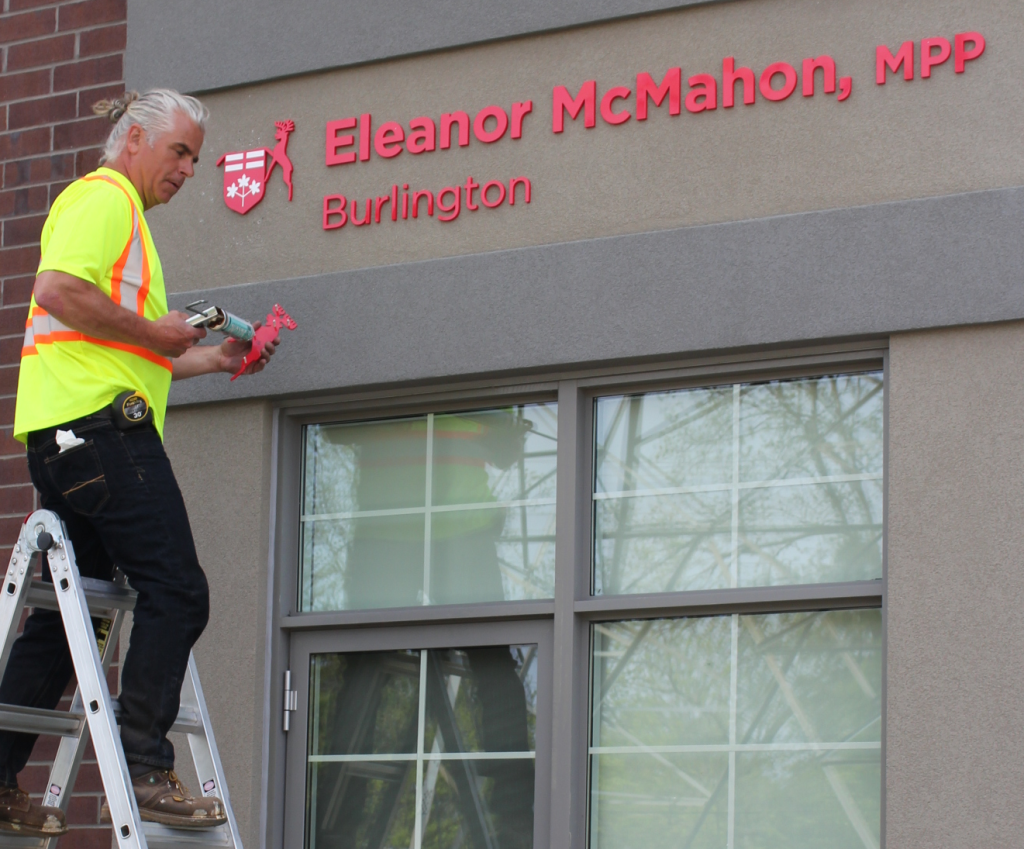 The only thing that hasn’t happened is picket lines outside the MPP’s office. In my role as MPP for Burlington, I have spoken with other parents, students, teachers and residents concerned about the impact of the PAR process. School closures and consolidations are some of the hardest decisions faced by our school boards given the critical role that schools play in the lives of Burlington families and our community more broadly.
Our schools have an impact that extends far beyond the classroom, which is why all residents deserve the chance to provide feedback so their input is reflected in the decision-making process. In my discussions, I have heard from constituents who feel that they have not had adequate time or opportunities to provide meaningful input. I have listened to these concerns and shared it in discussions with constituents, community leaders, trustees and the school board, outlining my expectation that Burlington residents have the chance to participate in consultations.
Decisions with respect to schools and school closures are made at the local level by local decision-makers: school boards (staff) and trustees (elected officials). There was a time, not that long ago, when schools were closed without due consultation. Our government changed this and has empowered local decision-makers to review school accommodation needs, entrusting our school board staff and trustees to ensure that student well-being is the number one priority.
School boards are now asked to ensure these decisions reflect consultations and input from impacted members of the community. The Ministry of Education’s pupil accommodation review guideline provides a framework for this, mandating that meaningful consultation take place.
Local input is essential for local decision-makers as they act on behalf of their community. I expect the Halton District School Board to listen and respond to requests from Burlington residents for more extensive consultation and ensure that their concerns are understood and dutifully addressed. This will ensure that Burlington residents have confidence in the process and therefore, the outcomes.
Encouraging community input is a fundamental principle in important decision-making processes like this and as the MPP for Burlington, I will continue to advocate on behalf of my constituents to participate and have their voices heard in these important discussions. Providing our students with the best educational opportunities remains a priority for me, and I expect that a meaningful consultation process will support a robust, high quality education system in Burlington and across the province.
Thanks again for reaching out to me.
Eleanor McMahon – MPP, Burlington
De Lugt wasn’t buying the response she got and shot back at McMahon:
Thank you for your email response but as a concerned parent in Burlington I am not naive in this flawed process that the Liberal Government has created for Local School Boards across this Province to follow. I am not satisfied with your “its not my issue” answer and that this is a decision of the School Board and local elected officials.
 Central and Pearson high school parents were outside in the cold weather demonstrating consistently. As a concerned parent that has witnessed first hand this flawed PARC process in Burlington watching communities pitting against communities to save their own school has been a true eye opener to the irresponsible reckless spending and the lack of accountability and transparency of our School Board and Provincial Government that we as parent entrust with our children with.
I work as a nurse in a hospital. We have adopted “A TIME OUT or Patient Briefing” prior to any major procedure such as an operation. The whole team from the surgeon, anesthesia and nurses in the operating room take a momentary pause prior to any operation making sure they ask these questions ( is this the right person, the right surgery, is it the right procedure) this allows the whole team to be on the same page making sure they are delivering the best care to the patient and to carry out the right procedure.
I encourage the Halton District School and the Provincial Government who’s popularity rating is at an all time low at 12% to take “A TIME OUT” which is a momentary pause in closing any schools in Burlington and across this Province. Please be patient and take a time out for approximately 3-5 years wait and watch approach and you will see your student numbers go up. With seniors downsizing and moving out of their homes young families are moving in the students will come.
Burlington is growing and there is projected growth north of the QEW that will be taking place in the next 5-10 years so we will need our schools
Closing schools are not the right thing to do. Schools are the centre of our communities and if the School Board closes one or two schools in Burlington it will severely impact the way this city looks and operates for many many years to come.
Each school has its own stories and its own unique programs and clubs that are important to their communities
I encourage the Provincial Government, Halton District School Board and the elected School Trustees to think very hard about any decision to close any schools in Burlington with the growth that will occur in Burlington and the lack of green space left to develop there will be a new look to this city with high density development which in turn will yield great number of students.
Sincerely, Cheryl De Lugt
Expect to see a lot more mail like this. The parents in Burlington have been putting up some very stiff resistance to the closing of high schools.

|
|
 Early in this academic year there were desperate pleas from the HSTS – Halton Student Transportation Service for people to apply for a part time job driving a school bus.
Early in this academic year there were desperate pleas from the HSTS – Halton Student Transportation Service for people to apply for a part time job driving a school bus.
























































































